#i miss 2004-2015 panic
Text
and with that, panic! at the disco can finally rest in peace
#it’s actually over holy shit#no more bad albums#no more brendon literally screaming on stage#and no more vlv and high hopes/hey look mom i made it live#which is a good thing but damn#this whole thing is just so bittersweet#i miss 2004-2015 panic#but now it’s actually over. like over over.#still pissed they didn’t bother to change the last show’s set list to feature old stuff#bandom#panic! at the disco#panic at the disco#ryan ross#brendon urie#dallon weekes#patd#pete wentz#afycso#jon walker#spencer smith#p!atd#vices and virtues#pretty odd#viva las vengeance#pray for the wicked#pretty. odd.#twtltrtd
27 notes
·
View notes
Text
My mum told me that whenever she hears "Panic! at The Disco" mentioned, she thinks of that one song, with the lyric "panic at the disco". She tried to find it for me but has no idea what it is. She thought it was a 90s song. She was typing in Google "panic at the disco song lyrics" but the problem with that is you only get songs FROM Panic! at The Disco. She went onto the music video for I Write Sins Not Tradegies because it was the first result, went to the comments and got confused by the people saying things like "i miss the old panic songs" so she thought that meant there were older songs than this one, so I had to tell her that those years old comments are referring to THIS song, which is now >15 years old. She didn't know p!atd was this old of a band though, she thought they were recent. So I looked up the release year of their first album and told her it's 2005. She is confused. Is she actually thinking of a p!atd song? Perssonally I don't know any p!atd songs where they say their own band name. I don't think there are any. We go to Youtube again. She remembers a music video by p!atd where "they were on a bus". High Hopes is the first result. I tell her she's probably heard that one because that's a popular radio song. It's not that one. She's typed in "panic at the disco tour bus video" or something, I don't think that's a good search because you'll get a bunch of results from p!atd on tour, singing live songs, which we don't want. She goes to the Hallelujah music video. "Oh they sung Hallelujah?" "No, that's his own song". She is concerned that Brendon Urie is in a precarious place in the music video but that's not it either. I'm scrolling through an article on all of the p!atd music videos ranked. I haven't seen the music videos so I don't know which one has the bus. Mum wonders how Panic! at The Disco even got their name. I look this up and tell her the result: "Panic! at the Disco got their name from an emo band you've probably never heard of called Name Taken. Brendon Urie and co. took inspiration from the Orange, California, band's 2004 track 'Panic,' which features the lyrics: 'Panic at the disco / Sat back and took it so slow / Are you nervous? Are you shaking?'" She looks up this song. We watch the music video for several seconds. That's not it. Dad comes in and asks what we're doing. Mum says I got her hooked on something. Dad says I shouldn't be selling drugs to family members. Mum asks him, does he know that one song, that goes "panic at the discooo" and it came out around the same time as that other song? Dad repeatedly says he doesn't know, he tells us to google it, to google "panic at the disco song lyrics". We tell him we've tried that, and he quickly realises that that's a really bad search term for what we want. He leaves. Mum tries to find again, those lyrics with "panic at the disco". I was already on a lyrics finder website, lyrics.com, that I was going to show her before she brought up the detail about the bus. There are 4 results for songs that say "panic at the disco", 3 of them are the same exact Troye Sivan song from 2015 that mum wouldn't be thinking of. The other is a song from 2004. We go to a lyric video. It's not that either.
We found absolutely no answers. We are both confused. What was that one song? WAS it by p!atd? On one hand, mum initially thought it was maybe a 90s song, but she didn't know p!atd is an older band than she thought. What's that music video with the bus? We will most probably never know.
1 note
·
View note
Text
Why Space Channel 5 is one of SEGA’s best dumbest games ever, no questions asked. (Report 1 & 1/2.)

Space Channel 5 on the Dreamcast is one of my favorite things ever, let alone favorite video games. Though I more often watch it on YouTube then actually play it.
For those not in the know, Space Channel 5 is a game series developed by United Game Artists and published by parent company SEGA. And that’s the most Wikipedia quoting I’m gonna do in this gush piece.
There aren’t many games quite like this rhythmic, Simon says game. At least in style because this game has that in spades, the gameplay anyone can do. And I am not at all qualified to explain its style because I wouldn’t how to describe it as besides maybe very 70s?
Point is there’s something charming about this game, and I think SEGA agrees with me on that. The lead character, Ulala (seen above), appear in these games to name a few years after new Space Channel 5 games stopped being made after 2002:
2004: Sega Superstars
2006: Sonic Riders
2008: Sega Superstars Tennis and Samba de Amigo
2010: Sonic & Sega All-Stars Racing
2012: Sonic & All-Stars Racing Transformed and Project X Zone
2015: Project X Zone 2
And not to mention the invading aliens have been skins of the titular Puyo Puyo in that series for a while I can’t determine. Possibly since at most 2007 up until current day with Puyo Puyo Champions in 2018/2019.
ALSO not to mention the VR game that came out recently! (How could I forget that? That’s the main reason I’m doing this.)
So it is clear SEGA loves this game and it��s sequel a lot. I don’t think their most beloved cult classic NiGHTS: Into Dreams gets that much love from the company though it certainly does get a lot itself, most games wish their parents still loved them that much long after they had a game. Anyway...
Now the part where I actually talk about the game.
I wanna say, first and foremost. This is not a review of the game. This is just gushing about why this game makes me happy.
And everything I’m gushing about is just what you get from the from one playthrough of the game. Save for one exception, I will not be talking about supplementary material, nor Space Channel 5′s lore.
And yes, this colorful dancing/rhythm/simon says game has lore. Basically any non-repeated character model has their own biograph. So I will not go into that.
You’re not missing too much, there are interesting tidbits, sometimes they fill you in on background details of the story.
Speaking of the story. I’ll start in a second. But if this is new to you, you can watch it here first (The first playthrough is only half the video):
youtube
Prologue:
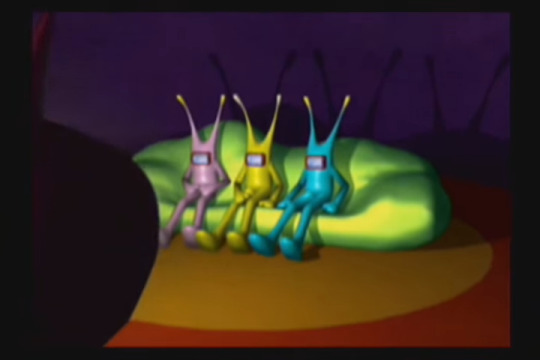
We start off with a bunch of alien sitting on a space couch watching space TV. These aliens are known as the Morolians and they’ll be the main antagonists for the evening.
This cutscene has no dialogue, so this is all open to interpretation for a first time viewer. Though I do enjoy this split second foreshadowing:
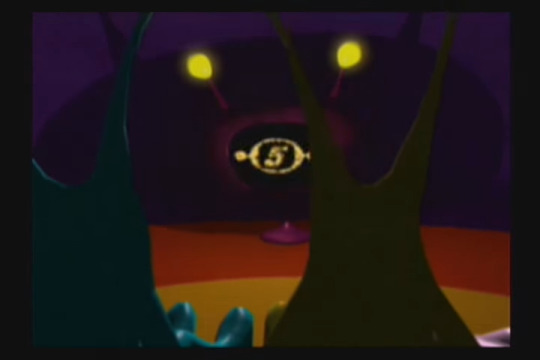
And that’s when the title screen appears. Blasting you with the series’ main theme Mexican Flyer. Look it up if you must. You’ll be hearing it a lot, it’s the game and Ulala’s leitmotif.

Report 1: This is terrorism attack on an airport... I’m gonna ignore that.
This is the only piece of supplemental material I’ll talk about, as it’s present in the game itself, but not elaborated on, and it is important to two of the character.
The game starts in a flashback. In the year AD 2489 a spaceship exploded. Everybody on board died safe for a little girl.

She was rescued by a man working for Space Channel 5. A news organization that with a specific focus on dancing. That last bit is nothing special though, as everything in this galaxy revolves around dancing.
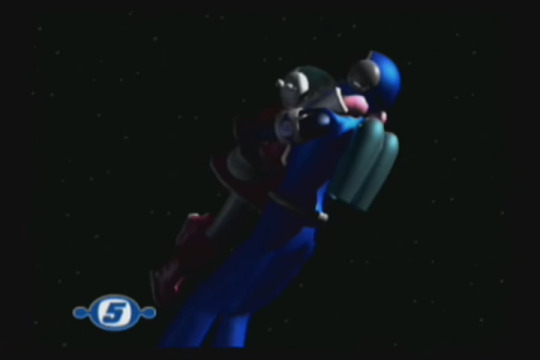
After the little girl is saved by this kindly Channel 5 Gent (Age 25) she knew what she wanted to be after she grew up. She wanted to be a sexy dancing reporter for Space Channel 5 just like him (presumably). And to meet him so she can thank him in person.
10 years later......


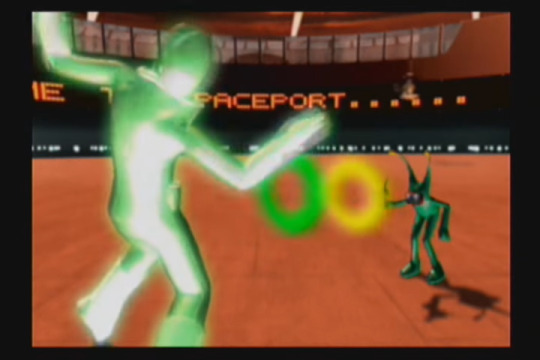
It is AD 2499! And the Morolians attack a space airport and their ray beams hypnotize people to dance silly.
THE HORROR!
And that’s when Space Channel 5 sends in Ulala to report on the progress.
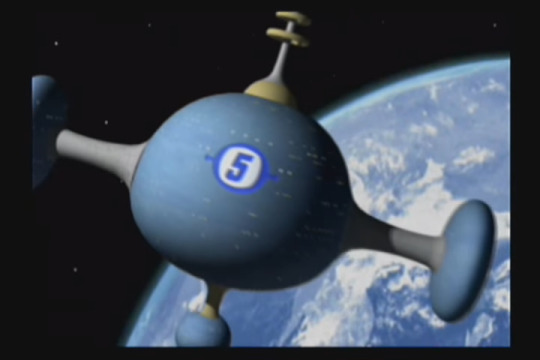
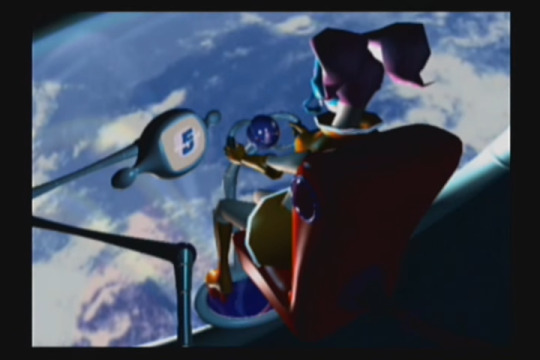
But what they’re actually doing is for Ulala to solve the problem instead of the Space authorities.
One character I do wanna mention now is that Ulala’s producer, Fuse, is an unseen character yet is important later. He’s the one briefing Ulala in the screenshot above. And oversees Ulala’s every move.
Also Ulala never got to meet her rescuer. He either left shortly after Ulala got rescued, or shortly before Ulala joined. Given what we learn later, likely the former.
Anyway onto the show:


BAM!

BAM!!
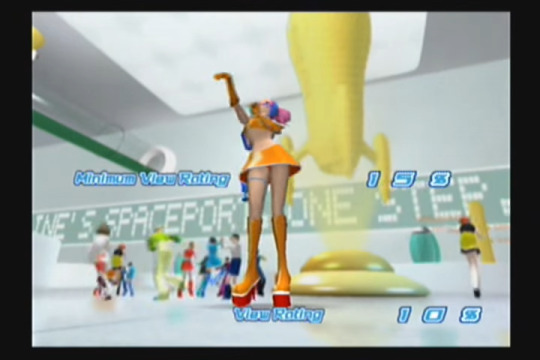
BAM!!!
I will always love that. Ulala got down on the ground in the panicking space air port to coolly report on the panic.
As quick aside, I wanna mention that Ulala doesn’t run in this game, she slowly struts and all of her struts are simply majestic. And those amazing struts lead her to the first gameplay section of this game.

Some Morolians hold a few hypnotized people hostage. This is is a dance battle. Meaning you got repeat exactly what the aliens do in the exact rhythm they did it in order to save the hostages. And I love this gameplay. It’s simple yet fun (provided you got minimal lag, you should look into that if you wanna play this game).
The controls are:
Up: Up
Down: Down
Left: Left
Right: Right/Light
Button 1: Chu (Aliens)
Button 2: Chu (Humans)
And this is how normal people settle things in this world apparently:
Party 1 (usually the Aliens) make up a tough but fair pattern for Ulala to copy in the hopes of psyching her out.
Party 2 (Ulala & Co.) gets as many chances ad she got. And the better she does more people tune into her news report. If she wins she gets what she wants. Saving the hostage and getting Party 1 out of her hair.
Every single one lives by this code of honor and I honestly have no clue if there’s an in-universe reason. But I love it regardless. I love it when people say: Up Down Chu Chu Chu. And the Ulala repeating it.
Though frankly, I don’t like it when the Morolians issue the commands. I like it when others do the exact same commands in this same game, so it’s a little bit of a bummer the Morolians do it.
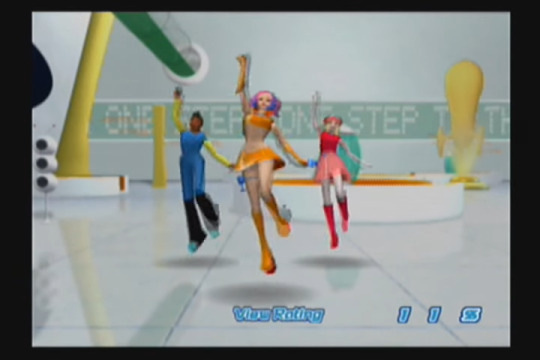
Anyways. You save the hostages and they join in on Ulala’s unstoppable strut as will always happen if you rescue people. And they strut to the second gameplay type: The Shoot-out.
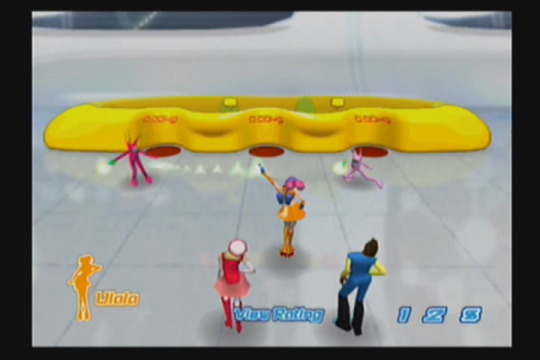
The controls are the same as the above but now you gotta watch out for humans in the mix.

In general these are trickier. And I might go into that later. But they do work on the same rules.
Don’t worry I won’t go over every dance or shoot-out unless there’s something special about it.
Also I’m pretty sure you kill people if you push the wrong Chu. Don’t do that, it’s bad for the ratings!
Skipping over three battles.Something new happens, rival space news station: Space(?) Channel 42 has a reporter of their own out on the field. And that reporter is planning to steal Channel 5′s viewership. And this is HER!
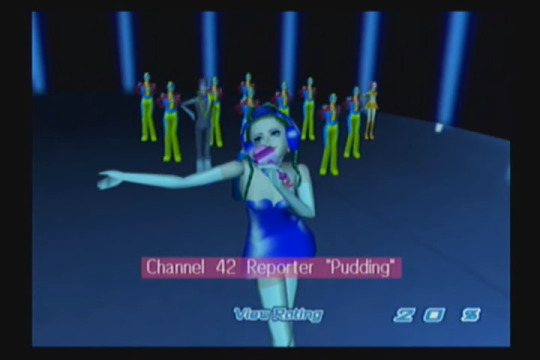
You do a dance battle and she dies.
Though seriously, I like this game does this. It’s not only aliens you fight, but other factions of the Space News Media. And it’s always a nice shake up when someone besides her shows up.
You see, for the most part any reoccurring enemy has recognizable mannerisms you gotta batlle, and her is no different. It’s hard to describe for me. You kinda gotta play or watch the game for yourself to see what I mean, but I think it’s best exemplified in Report 2. And the following games.
Though one thing’s for sure, each non-normal Morolians or rival reported does bring their own genre switch with them. Heck sometimes even normal battles have unique genres. I’m am not musically inclined so I wouldn’t know hers or most others.
Any way, before she dies she give an emotional speech and gracefully suggests to take her Channel 42 guitarist with her and Ulala accepts that’s the least she could do for a lousy reporter like her.
And then it’s boss time!
Yeah, actual bosses with actual boss characters. And not like the recently deceased as shown above. She’s practically for all intents and purposes another Morolian dance battle.
And it’s down to funky jazz music, not unlike what you’d see in Sonic Adventure! Even Ulala comments on it, confirming it’s dietetic Where does it come from? Not sure, there might be an explanation somewhere. But do keep that in mind. That the music we hear is also the music the characters hear as well.
Anyways:
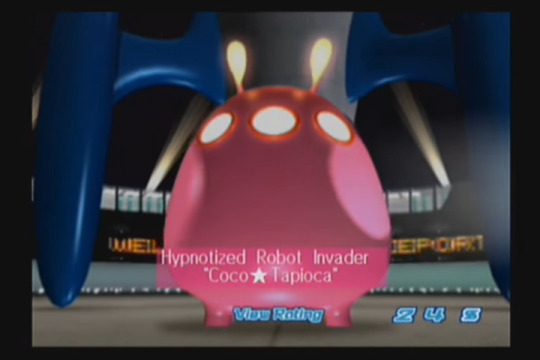
Not Pictured: Super Stretchy Arms.
I think it’s a bit of a misnomer. Invader is correct, that’s what it’s here for. But is it really a robot? It moves like an organics and is a bit rubbery. This basically goes for all Morolian robots.
I can suspend my disbelief. You shouldn’t nitpick too much about Space Channel 5, it doesn’t want you to think too hard about it’s world even if there’s a lot to it. I’d be concerned if Space Channel 5 did wanna put its story and world building first and foremost.
But “Hypnotized Robot Invader”?
What?
Spoiler.
Robots and hypnotism... I’m pretty sure a sign that we made perfect human-like Artificial Intelligence if they can fall susceptible to Hypnosis. Even then I doubt it.
Sorry, that’s always bothered me, I get what they mean by it. It’s just the word choice... Did they mean Hypnotizing Robot Invader? This boss is great.
It starts off with a normal dance battle, but you get to watch a new Morolian enemy’s moves. It’s also quicker on the draw along with a few softballs to throw your timing off. Pretty good stuff.
And that applies to the next phase as well, where the the shooting starts.


I don’t have much to say.
Unlike the robot’s final phase where it’s the first phase again, but with guns and the robot goes to berserking speeds with the input commands.

And after you beat it, it joins you in a strut.
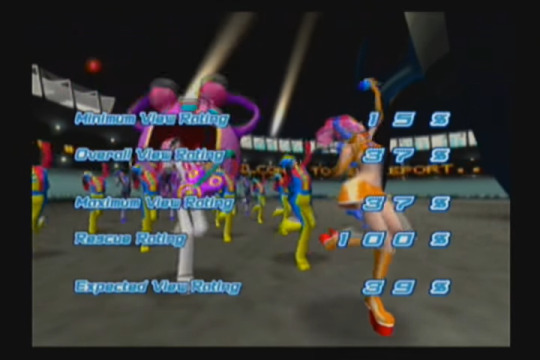
As does everyone you saved, No matter the gender, nor age, nobody is embarrassed imitating Ulala no matter what she does. We’ll be half as lucky to get a cool future as cool as 2499.
And with that the first report is over.
Report 2: (Age 35)
At the Morolian HQ (Presumably), their boss doesn’t like failure.
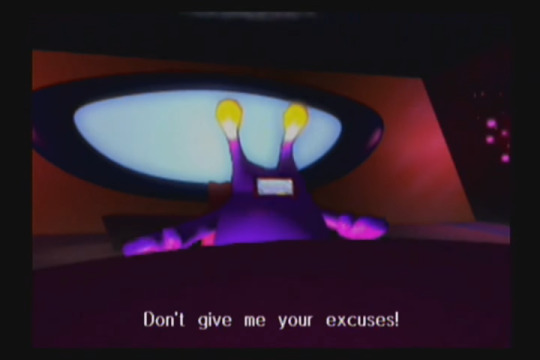
But like a good boss he doesn’t dwell on failure and moves on to the next plan. One of his lackeys has this plan: Another boss battle dance robot who operates on:

The everyone at the table is impressed. So I guess Ulala is screwed, game over.
This level is more of the same as the last one more or less, it’s possibly the most boring level in the series in that regard. It’s not bad, this is just the game bulding enough a status quo before they change things up in Report 3.
But that doesn’t make this level any less interesting to talk about, so I won’t go over it much.
The short story until something new happens is: Space Ship (think of it as a fancy yacht but in space) is being attack by Morolians, Ulala is send to report on it, and being the professional she is saves hostages as well.
She saves the captain, crew members, stewardesses, waitresses, the Space Diva (OH NO! NOT THE SPACE DIVA!), passages and the like.
UNTIL!
He voice says “I’m gonna steal you show, Space Channel 5”. And you see this ship flying by:
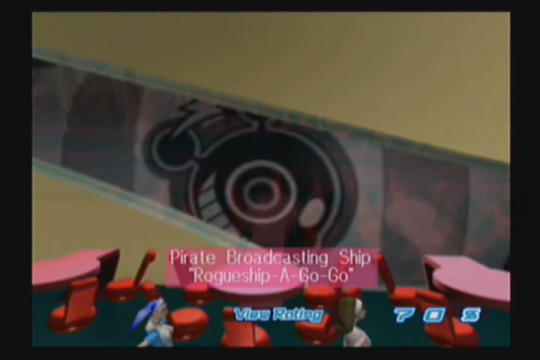
Another rival reporter, this one a pirate broadcasting station.
Side note: That’s sounds like the most important kind of pirate ever. Alternative news/non-mainstream with no money/rating motive blinding everything with journalistic integrity? Yes, by all means. If they’re pirates then so are Secular Talk & The Humanist Report.
Back to the silly dance game. The Pirates either jam or hack Channel 5′s signal and the Ulala is stuck with them for a while.
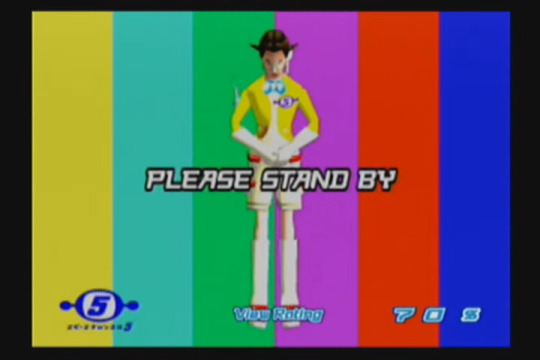

And then we meet that where we meet the gent above.
“[His] name is:“

“JAGUAAAAARRRR!!!”
“JAGUAAAAARRRR!!!“
(Age 35)
LET’S DANCE!
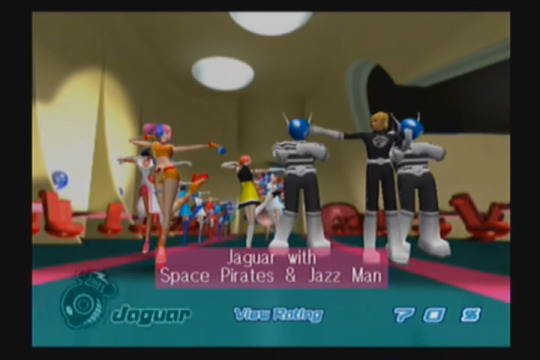
Dude, I love Jaguar (Age 35) he’s gotta be my second favorite character in the series on account he’s just cool and incapable of embarrassment.
Remember the deceased of the last report? The Channel 42 reporter in the blue dress? He’s her counterpart for this chapter.
But whereas the deceased’s gimmick sounded air headed for a lack of a better term. Maybe, girly? Point is, battling her didn’t feel too dissimilar to battling Morolians despite her rhytmic mannerisms.
Jaguar (Age 35)’s gimmick is that he just adds. He starts with a simple Up. And then he adds a Chu, and another Chu. Eventually it becomes a really long chain of commands, it has to be some of the longest in the series. And you have to do them all from start to finish because he does them all sequentially. Can you repeat?:
Up. Chu. ChuChu. Right. Left. Down. DownDown. Down. Chu. Chu. Chu.
He is easing you into it, but it is by no means an easy fight. Because after the chain is at its longest, he just spamming ChuChuChu in quick succession. And then a simple Chu.
After defeat Jaguar & Co, escape by jet-pack, saying they will meet later.

This battle is a highlight for me. Coco Tapioco and the big bosses to come are better if you ask me (with exceptions). But Jaguar (Age 35) is some of the best the normal gameplay goes.
And you could argue what normal means in the context of Space Channel 5. But effectively, like Channel 42′s deceased, functionally he might as well be another Morolian if he wasn’t there to be set up for later. Because you do get person that just joins your Strut Club like everywhere else.
You gain his Jazz Man and you get a great sax solo as a reward beating him. Like how you got Channel 42′s guitarist for beating them. I like the think the Jazz Man can work for Jaguar (Age 35) again while the Channel 42 Guitarist is blacklisted.
And before we move on from Jaguar (Age 35) check out his Chu pose:

BOSS TIME!
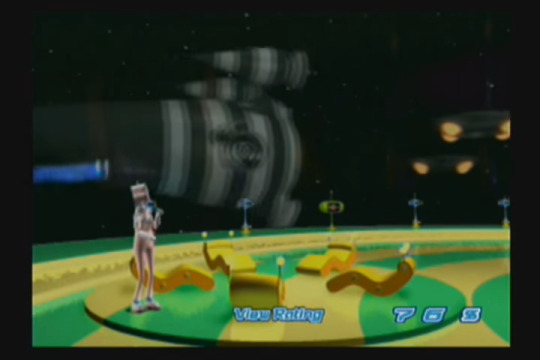
Jaguar (Age 35): The alien mothership is retreating. Don’t you have to follow them, Channel 5?
Fuse: Blast you, Jaguar [Age 35].
With the pirates giving chase, Ulala is left with the cowardly alien robot to elegant music.
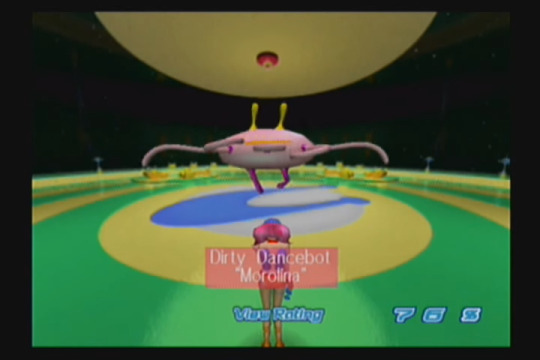
Ignoring the robot’s title, while silly, its cowardice is its greatest asset. For it has kidnapped some space schoolkids, making their space teacher worry. Their space teacher can actually be seen at the start of the report.

Space fashion, am I right?
I’ve exceeded Tumblr’s invisible limit of what to put in a blog post. I’ll have to rewrite this boss what I have to say for this boss. So full, can’t spell check! We’ll be back!

#space channel 5#sc5#ulala#dreamcast#chu#gushing#jaguar#fuse#pudding#coco tapioca#morolina#morolians
7 notes
·
View notes
Text
An Introduction

(NOT MY GIF)
AN INTRODUCTION TO CAROLINE STARK
A/N: Hi! Thanks for reading! So, after months of waffling about wanting to write, I finally sat down and did it. It’s pretty complicated, so it’s pretty important to read this one before you start with anything else. I’ve created an original character, who lives in a slightly alternative universe to the one we were left with after Endgame. I’d like to state that none of my personal changes are reflections of my opinions of what DID happen, but in order to build her as I wish, some things needed to be slightly different.
1) Steve didn’t go back to Peggy after he returned the stones
2) Hulk and Banner didn't become one, they’re still two separate beings
3) Natasha was brought back by Steve as he was able to return the soul stone in return for her life
4) The compound was rebuilt after the Battle of Earth. There is a memorial for Tony where he died.
A few other things to note:
1) My first piece of writing will be a background that is applicable to all of the fics. However, many of them will be stand alone, unless I state otherwise. I’ll be creating a masterlist which will lay everything out very clearly, but please feel free to ask if you need to 😊
Thanks for reading the boring stuff. Everything will be up soon!
Summary: An introduction to the secret Stark sister. Who is she? Why was she kept a secret? And what happens when everybody finds out?
Warnings: Abandonment, injury, PTSD, death, blood, but there's plenty of soft love too.
Word count: 1921
SUMMER 2004
MALIBU, CALIFORNIA
"Yes, yes, two seconds!" Tottering over to the front door of her bosses lavish Malibu home, Pepper Potts grumbled under her breath, annoyed by the fact that she was the one answering the incessant knocking. "I’m not your maid, Tony!” Sighing, she unlocked the door and prepared to shoo whichever reporter, play bunny, or cold caller had decided that 10 PM on a Tuesday evening was a good time to show up. However, she was greeted with something entirely unexpected.
“Oh! Hello! Are you lost? Where’s your Mom?" In front of Miss Potts stood a small girl, 7 years of age, a sparkly pink bag held tightly in her little hand. Pepper greeted the young girl with the cheeriest voice she could manage in her surprise. Sticking her head out of the door, she looked around, but with a furrowed brow she realised that they were alone. There wasn’t another figure or car in sight.
“Momma said I had to give you this." In her tiny outstretched hand was a thick envelope. "She said my Daddy lives here.” The look on her face told Pepper that she knew exactly what had happened. Even as young as she was, she had an obvious maturity that would break hearts. Her mother had abandoned her, and the girl understood that entirely.
With eyes so wide it hurt, Pepper took the envelope, peeking inside to find a passport, a letter, and a photograph of Mr Stark and a woman. The girls' mother, Pepper presumed. Shock was written into the PAs face, but she forced a smile all the same. After a quick look at the passport, she ushered the child inside.
"Come on in, Caroline. We’ll sort you out, okay?”
LATE 2008
NEW YORK
A series of loud bangs on her bedroom door pulled Caroline from her daydream. Not even having a chance to respond, the door burst open and three young girls practically fell into her room.
“Turn the TV on!"
“As if you weren’t famous enough!"
“Did you know? You must've known?!"
Wide eyed and clueless as to what her friends were talking about, Caroline blinked back gormlessly as Amelie grabbed the remote and turned the TV on.
“What channel?“
“Can somebody tell me what the hell is going on?" The 11-year-old spoke up, and all three heads turned to face her, humour in their eyes as they stated what was seemingly obvious.
“Your dad, Care.” Caroline knew her Father had been in some trouble. Happy had shown up outside the halls of residence, whisking her away immediately. The panic set in as her heart sped up violently. As the girls scrambled through the channels, they froze as a man in a suit appeared on the screen. Caroline's dad. Tony Stark. They watched in awe as he addressed his audience. As his daughter, she'd watched a few press conferences before. They were a bore, however, she couldn't lie.
The TV remote fell from Amelie’s hand as he spoke the four words that changed history.
“I am Iron Man.”
MAY 2012
MANHATTAN, NEW YORK
Footage of the Chitauri destroying the very ground she stood on flashed through Caroline’s mind. Gripping Happy’s arm as she sobbed, the 14-year-old girl cried out desperately for her Father. Their relationship had been very rocky for a while. He’d rejected his new responsibility at first, leaving Pepper to parent the girl. He’d even shipped her off to boarding school, where he further pushed away his long-lost child. It wasn’t until Pepper dragged him by the sleeve to the young girl’s dorm room and forced him inside that he’d actually spoken to his daughter. From there, they established a solid relationship. Caroline, of course, fell head over heels for her Father. He could do no wrong in her eyes. That never changed, even as she grew.
Fear wracked her body at the thought of Tony not surviving the battle. Staring at the sky, she prayed and prayed that he return from that giant swirling hole of death that currently dominated New York. When she saw his body fall through the sky, her fear both vanished and increased ten-fold.
-
Later that evening, JARVIS informed her of her Fathers arrival at the beaten-up tower. Racing to find him, she threw her arms around his neck and cried. She cried and cried until she ran out, but she never let go of his hand.
MAY 2015
NOVI GRAD, SOKOVIA
“Daddy?” Her voice came out a whimper. She felt weak and small.
“Hey baby girl, I’m uh…I’m guessing you’ve seen, right? Yeah, it’s bad, Care.”
“Dad, what’s going on?”
“Listen, baby, I’ve gotta end this. Me and Thor, uh, we think we’ve got a way. A lot of people will die if we don’t do this. You're the best thing, you know?" His voice was soft, even as he continued to fight off robots and save the world. The line grew staticky and Caroline couldn’t stop the tears that spilled from her eyes. "I'm so glad you showed up on my doorstep all those years ago. I’m sorry for taking so long."
“Why does it sound like you're saying goodbye? Daddy you're scaring me!” Her voice was a desperate whimper, and a pain in her chest bloomed violently.
“I love you, Caroline. Remember th-" Horror erupted over her features as the line went dead. Not knowing whether she'd ever see him again, she made her way to New York, her heart dragging painfully behind her.
NEW YEARS EVE 2015
AVENGERS COMPOUND
UPSTATE NEW YORK
Caroline and her Father walked through one of the many laboratories of the new compound. On her 18th birthday the Stark girl was offered a position as a biomechanical engineer for the new era S.H.I.E.L.D. program, built following its collapse in 2014. Taking after her Dad, she had excelled in school, and to the amazement of her new bosses, had landed a glowing recommendation from Iron Man himself. The decision for her to live under a different last name to Tony was one he himself had requested in a bid to keep her safe for as long as he could. She had never really met the other Avengers, and only three other people knew of her existence; Pepper, Happy, and Natasha Romanoff. It was easy enough to hide her identity.
Caroline didn’t mind too much. She could still see her parents as much as she pleased, and it prevented any special treatment from schools and professors. Those around Caroline herself knew; her school friends knew, she didn't want to keep a secret from them, and besides, she didn't know any better when she told them at 8 years old.
“How’re you settling in? Are you sure this isn’t too soon? This is too soon. I’m taking you-“ midway through his rambling, Tony realised his daughter both lived and worked at the compound, rendering his threat useless. "I'll take you somewhere. Details, schmetails."
“Dad! Calm down! You’re spiralling. I’m fine, I’m settling in just fine! Now come on, I need to meet everyone.” A proud smile graced the young girls features as she tried to rid her rather of any worry. With a sigh, he took his daughters hand in his own and led her to the Avengers quarters. Separating just before they entered the room, Caroline took a shaky breath.
“Folks gather round. This is our new Doc. With Banner MIA," his brows drew together as he spoke, and his gaze fell to the floor for a second before finding Caroline "she’s our go to! This is Caroline. Caroline Lockwood.” A half smile appeared on his face, the bittersweet moment getting the best of him. After a few brief introductions, the girl bid them goodbye to get ready for one of Tony Starks famous New Year’s Eve parties.
JUNE 2018
AVENGERS COMPOUND
UPSTATE NEW YORK
Pepper sat with her daughter, a blanket around the two of them as they hid. They sat in silence, unable to find the words. Trying to maintain hope when everything around them told them to give up was the hardest battle they'd fought yet. “Momma? We’ll be fine, right? We always win.” Her voice nothing but a whisper in the darkness, she felt her adoptive mothers’ fingers tighten around her own.
“We'll be fine, baby. Your Dad will do what he always does. He'll save us. He'll save everybody.” The sad smile on Caroline's face couldn’t be seen in the dark, but Pepper could tell the moment that it fell. She felt the energy in the air shift. Did they lose? “Baby? Baby what’s wrong?" Placing her soft hands either side of her daughter’s face, she gasped sharply as the blanket fell around them, no longer supported by two bodies. Instead, a dark ash took the place of the youngest Stark.
“I’m sorry, Momma" she choked out before disintegrating completely "I'm sorry.”
Pepper was left alone, covered in heartbreak, grief, and the ashes her child left behind.
OCTOBER 2023
ATLANTA, GEORGIA
"Hey, sweetie. Do you want Mom?" Morgan shook her head and stepped closer to her sister.
“Can you help me? You’re my sister.” With sad, glazed over eyes, Caroline nodded. It's not difficult to sympathise with the two girls. Morgan knew all about her big sister. Stories were told, and pictures were framed in every inch of the house. Morgan idolised her before she’d ever met her. And when, by some miracle, they did meet, it was a few days before their fathers’ funeral. Two days before that, Caroline had been dead.
Dead.
It'd been one hell of a week.
To say the oldest Stark sister walked on eggshells around the younger one would be an understatement. Allowing their relationship to be on Morgan’s terms was the least she could do. The thought that Morgan may reject her completely never left her mind, despite Peppers constant reassurance. “I can braid your hair, if you’d like. Momma taught me when I was a little girl."
-
"Where's Morgan?" Pepper's voice barely registered in Caroline’s brain. She could feel herself drifting further and further away every day. But she didn't have the strength to fight it.
“Happy took her for cheeseburgers.” A hint of smile traced her mouth, but it didn't stick. It never stuck. The bags under her eyes were heavy and dark, and the once rich brown of her eyes seemed to have dulled miserably. After receiving her own private recording from Stark, she felt as if she'd broken completely. Turning to face Pepper, she struggled to continue, her voice hoarse from crying and screaming in the night. "They should be back an-"
“MOMMY SISSY UNCLE HAPPY BOUGHT EXTRA.” Watching the tiny girl stumble through the door, a brown paper bag clutched tightly to her chest, Caroline just stared in awe. Of course, Morgan was too young to really understand what happened. She missed her Daddy, and she knew he wasn’t coming home, but she managed to smile. Her eyes shined bright as ever. The world hadn't tainted her hope, it hadn’t torn away her faith.
It would be so, so easy to just let go. To just give up and fall into the oblivion that called her name. But in doing so, she'd miss even more time with her sister. Watching her eat with a pensive look on her face, clutching on to Pepper and watching all the strangers around her, Caroline made a choice. She could do it for Morgan. She could hold on and keep going.
So, she did.
TAGS:
@bucky-castiel
#marvel#mcu#tony stark#iron man#pepper potts#morgan stark#the avengers#fanfiction#ironman#captain america#the winter soldier#hawkeye#hulk#black widow#writing#angst#fluff#love#smut#series#original character#oc#Stark!OC#please read#oh god#my first one#requests are always open#please tell me what I do wrong#tumblr#art
76 notes
·
View notes
Link
via Politics – FiveThirtyEight
America is a little matryoshka doll of panic right now; pop open each layer to reveal a new, worrying scenario. For months the country was focused on reopening the economy, which had its own complicated set of problems. But only recently has a broader swath of America tuned into the mess nestled inside it, one that parents have been sitting with for months: what to do with the kids.
There has been no federal plan to help American parents with child care, and they continue to wonder whether schools will really open their doors come the new school year. That lack of action is in direct contrast to other crises that have struck America recently. After the financial crash of 2008, there was a bailout and a stimulus plan. After the protests against police over the last few months, officials in cities and states responded with promises of better actions in the future but also, immediate policy implementation: New York state repealed a law that had shielded police personnel files, while the Minneapolis City Council voted to begin a process that could eventually lead to the dissolution of the city police as it’s now known.
But on child care and school, a specific, urgent response has been missing, or at least one that acknowledges our new reality. President Trump threatened to withhold federal funding for education if schools didn’t open back up, counter to schools’ insistence they need more money to provide a safe education amid the pandemic. While the CARES Act, an omnibus COVID-19 relief bill signed into law in late March, gave extra stimulus funding to families with children, schools and child care businesses so they could remain afloat, a Democratic-backed bill to give a $50 billion bailout of the child care industry has gotten little attention. Teachers around the country have voiced doubt that necessary safety measures for in-school teaching will be sufficient, and Los Angeles Unified School District, one of the country’s largest school systems, has decided not to reopen classrooms when schools go back in session in August. Some worry that while distance learning is safer, socially different children and those without stable internet connections or computers — who are already at the margins in normal times — will fall irrevocably behind.
There is no cohesive solution to America’s child care problem. But the relative inattention to this crisis, one that’s so foundational to a functioning society, the economy and family units across the country, is revealing. It shows that for all the changes that have happened in American life — more female elected officials, a MeToo movement and a workforce that is around 47 percent female — our power dynamics remain fundamentally skewed. We are failing to collectively understand what our most critical and pressing problems actually are.
“Care in general has always been seen as a sideline issue,” Vicki Shabo of the left-leaning think tank New America said. “A nice-to-have and not something that’s necessary, and not something that’s central for adults to be productive in the economy.” Of course, now we’re seeing how much of a misunderstanding that is. In a country where most men and women work even when they have children, having child care is inextricably linked to economic productivity — and not having it often hurts women most. U.S. Bureau of Labor Statistics data from 2015 found that in households with children under 6, women spent an hour a day doing child care, compared to the 25 minutes of care provided by men. It’s easy to extrapolate this trend for pandemic times: American women will bear the brunt of the school and child care crisis.
Yet, child care in particular hasn’t often found itself at the forefront of political debate. Experts and activists I talked to for this story all used the same framing to talk about why: an American narrative that child care problems are individuals’ problems, not society’s.
“If you think about child care traditionally before the pandemic, you probably didn’t think about it too much before you had kids,” Melissa Boteach, vice president of income security and child care at the National Women’s Law Center, said. “Then you have kids, you’re in the most stressful and resource-strapped part of your life: You’re operating on three hours of sleep a night, you’re financially squeezed, because at the very time you’re taking off of work, you have diapers and wipes and formula and whatever else. You’re in this total daze of early motherhood. That’s probably not the time when you say, ‘You know what, I’m going to call my member of Congress.’ You’re feeling it like a personal issue.”
Child care isn’t necessarily seen as a macroeconomic issue or a driver of labor force participation or GDP, Shabo said. And because of that, she said, it often takes a backseat to economic issues like wages when lobbying efforts happen. This is not to say that child care issues don’t get attention — in the 2020 Democratic presidential primaries, which featured several female candidates, child care plans took a more front and center role in the campaign than they had in the past. One leading candidate, Sen. Elizabeth Warren, co-authored a 2004 book, “The Two-Income Trap,” which was about the ways the rising incomes of households with two full-time employed adults belied the heavy costs of essentials like child care. Warren thought child care costs were among the reasons the American middle class was in an economic crisis.
“Our workplaces were built for white men,” said Danielle Atkinson, the founder and director of Mothering Justice, a Detroit-area advocacy group for working families. The fact that parents are left to fend for themselves from birth to kindergarten and then during the after-school, pre-dinner hours, is an American tradition that seems to assume a readily available, at-home caregiver. (Atkinson pointed out the inextricable role black women have played in American child care; enslaved women often took care of white children.) The nuclear family with a stay-at-home parent (usually a mother) is an ideal that persists, or at the very least lingers in American life: only 18 percent of Americans in a 2018 Pew Research Survey thought it was ideal for both parents to work full time.
“This conversation about school is really a conversation about work,” Atkinson said. “The conversation about returning to school is not based on health. It’s about returning those workers to working and not looking after their children, so those children have to be somewhere.” Essential workers in particular are being forced to make difficult choices about their children’s care — many essential-worker jobs are lower wage — and many child care providers are in strapped situations. The work of child care providers, Atkinson said, is often undervalued — their median annual wage in 2017 was a little more than $22,000 annually, which is just above the federal government’s poverty line for a family of three — and as Boteach pointed out, those workers could continue to risk greater infection rates as schools and work open back up. She highlighted the plan put forth by Senate Democrats, the Child Care Is Essential Act — which would provide a bailout to the suffering industry and additional money for those providers to buy personal protective equipment — and cited an estimate that the U.S. child care industry would need a $9.6 billion injection monthly to survive the pandemic.
It’s more likely the next governmental nod to parents and their school-age children will come in the next iteration of the omnibus coronavirus relief package. Congressional Democrats have proposed $350 billion in funds for schools and universities to purchase PPE and clean their facilities. Republicans agree about more funds, though it’s not clear what their proposed number is — some have argued that since many schools will be operating on a partly virtual basis, less federal funding is needed.
The moral tussling that many parents have been doing — go back to work and risk potential COVID-19 infection at day care or school — will likely continue to be subjected to partisan politics. Trump and his Secretary of Education Betsy DeVos have been the loudest voices in recent days about sending children back to school at all costs, much to the chagrin of teachers, many of whom feel ill-prepared for the safety precautions necessary for in-person pandemic teaching. Ultimately, though, it is parents who are forced to make a choice. Atkinson, a mother of six, told me she would be keeping her children home in the fall.
For those who focus on child care, the pandemic has perversely presented an opportunity to advance the cause of greater access to guaranteed services. “This pandemic has created greater alignment of experience, potentially, between white middle class folks who saw this as an individual issue that they were struggling with and outraged by but hadn’t really taken action on and the longtime, long-standing lived experience of lower wage folks and people of color who have struggled for decades with the unaffordability of child care and the lack of care options to meet their work schedules,” Shabo said.
Atkinson said she also hoped the individualism narrative would be shattered by the current crisis. “We want to lift the veil away and help women, especially white women, know that you’ve been lied to. You were sold a bunch of lies: ‘if you just work harder, if you just slay sexism, you’ll be OK.’ But really, it’s a tool to divide,” she said.
The pandemic has shattered norms and paradigms ever since it arrived in the U.S. — our expectations of child care is no exception. What some politicians and activists had long sought to do to no avail — place working parents and their child care crisis on the center stage of American politics — the virus has done in a matter of months.
4 notes
·
View notes
Text
Thinking Through Interfaces, a syllabus
*That looks enlightening.
THINKING THROUGH INTERFACES
Co-taught by Zed Adams (Philosophy) and Shannon Mattern (Media Studies)
Tuesdays 4:00 - 5:50pm | 6 East 16th St #1003
Interfaces are everywhere and nowhere. They pervade our lives, mediating our interactions with one another, technology, and the world. But their very pervasiveness also makes them invisible. In this seminar, we expose the hidden lives of interfaces, illuminating not just what they are and how they work, but also how they shape our lives, for better and worse. We also discuss a number of pressing social and political issues, such as why we are quick to adopt some interfaces (e.g., smartphones and social media platforms), but reluctant to embrace others (e.g., new voting machines and Google Glass).
(...)
RESOURCES
With a few exceptions, all readings will be made available on our class website, at http://www.wordsinspace.net/interfaces/2019/. We’ll provide everyone with a copy of Tom Mullaney’s The Chinese Typewriter and David Parisi’s Archaeologies of Touch.
SCHEDULE OF MEETINGS
WEEK 1: JANUARY 22: INTRODUCTIONS
What is an interface?
How are interfaces differentiated?
Can an interface become a part of our mind?
Do interfaces shape what we use them to do?
What are the limits of interfaces: what problems do they not help us solve?
WEEKS 2 AND 3: CONCEPTUALIZATION
WEEK 2: JANUARY 29: CONCEPTUALIZATION I
Nelson Goodman, “The Theory of Notation” (Chapter Four), Languages of Art (Hackett, 1976): 127-173.
Florian Cramer and Matthew Fuller, “Interface” in Software Studies, ed., Matthew Fuller (MIT Press, 2008): 149-53.
Johanna Drucker, “Interface and Interpretation” and “Designing Graphic Interpretation” in Graphesis: Visual Forms of Knowledge Production (Harvard University Press, 2014): 138-97.
WEEK 3: FEBRUARY 5: CONCEPTUALIZATION II
Shannon Mattern, “Mission Control: A History of the Urban Dashboard,” Places Journal (March 2015).
Shannon Mattern, “Things that Beep: A Brief History of Product Sound Design,” Avant (August 2018).
We encourage you to think, too, about how interfaces might embody different cultures and ideologies. Consider, for example, feminist interfaces or indigenous interfaces -- or interfaces that embody universal, accessible design. You'll find some relevant resources in the modules at the end of this syllabus, and we'll explore many of these themes as part of our case studies throughout the semester.
In-Class Workshop (second half of class): small-group interface critiques
Supplemental:
Christian Ulrich Andersen and Soren Bro Pold, eds., Interface Criticism: Aesthetics Beyond the Buttons (Aarhus University Press, 2011).
Martijn de Waal, The City as Interface: How New Media Are Changing the City (nai010, 2014).
Johanna Drucker, “Humanities Approach to Interface Theory,” Culture Machine 12 (2011).
Johanna Drucker, “Performative Materiality and Theoretical Approaches to Interface,” Digital Humanities Quarterly 7:1 (2013).
Florian Hadler and Joachim Haupt, “Towards a Critique of Interfaces” in Interface Critique, eds., Florian Hadler and Joachim Haupt (Berlin: Kulturverlag Kadmos, 2016): 7-16.
John Haugeland, “Representational Genera” in Having Thought: Essays in the Metaphysics of Mind, ed. Haugeland (Harvard Univ Press, 1992): 171-206.
Branden Hookway, Interface (MIT Press, 2014)
Interface Critique (journal).
Steven Johnson, Interface Culture (Basic Books, 1999)
Matthew Katz, “Analog Representations and Their Users,” Synthese 193: 3 (June 2015): 851-871.
Kimon Keramidas, The Interface Experience - A User’s Guide (Bard Graduate Center, 2015).
Shannon Mattern, “Interfacing Urban Intelligence,” Places Journal (April 2014).
Don Norman, The Design of Everyday Things (Basic Books, 2013).
Mitchell Whitelaw, “Generous Interfaces for Digital Cultural Collections,” Digital Humanities Quarterly 9:1 (2015).
Jeff Johnson, Designing with the Mind in Mind (Morgan Kauffmann, 2014).
WEEKS 4 AND 5: TYPEWRITER KEYBOARDS
Our first case study is the QWERTY keyboard. This case raises fundamental questions about why interfaces are adopted in the first place, the extent to which their original designs constrain how they are subsequently used, and how particular linguistic politics and epistemologies are embodied in our interfaces.
WEEK 4: FEBRUARY 12: KEYBOARDS & QWERTY
Andy Clark, Chapters One through Three, and Ten, Being There: Putting Brain, Body, and World Together Again (MIT Press, 1998): 11-69 and 193-218.
S. J. Liebowitz and Stephen E. Margolis, “The Fable of the Keys,” The Journal of Law & Economics 33:1 (1990): 1-25.
WEEK 5: FEBRUARY 19: OTHER KEYBOARDS
Thomas S. Mullaney, The Chinese Typewriter: A History (MIT Press, 2017): Chapter 1, 35-74; Chapter 4, 161-93; Chapter 6, 237-53 (up through “How Ancient China Missed…”; and Chapter 7, 283-8 (through “China’s First ‘Model Typist’”).
Kim Sterelny, “Minds: Extended or Scaffolded?” Phenomenology and the Cognitive Sciences 9:4 (2010): 465-481.
See Marcin Wichary’s forthcoming book about the global history of keyboards, as well as his research newsletters.
4-5pm: Skype TBD
Supplemental:
Louise Barrett, Beyond the Brain (Princeton University Press, 2015).
Andy Clark and David Chalmers, “The Extended Mind,” Analysis 58:1 (1998): 7-19.
Friedrich A. Kittler, Gramophone, Film, Typewriter, trans. Geoffrey Winthrop-Young and Michael Wutz (Stanford University Press, 1986).
Lisa Gitelman, Scripts, Grooves, and Writing Machines: Representing Technology in the Edison Era (Stanford University Press, 1999).
John Haugeland, “Mind Embodied and Embedded,” Having Thought (Harvard University Press, 1998): 207-237.
Richard Heersmink, "A taxonomy of cognitive artifacts: function, information, and categories." Review of philosophy and psychology 4.3 (2013): 465-481.
Richard Heersmink, "The Metaphysics of Cognitive Artefacts," Philosophical Explorations 19.1 (2016): 78-93.
Neil M. Kay, “Rerun the Tape of History and QWERTY Always Wins,” Research Policy 42:6-7 (2013): 1175-85.
Prince McLean, “Inside the Multitouch FingerWorks Tech in Apple’s Tablet,” Apple Insider (January 23, 2010).
Jan Noyes, “QWERTY - The Immoral Keyboard,” Computing & Control Engineering Journal 9:3 (1998): 117-22.
Kim Sterelny, The Evolved Apprentice: How Evolution Made Humans Unique (MIT Press, 2012).
Cassie Werber, “The Future of Typing Doesn’t Involve a Keyboard,” Quartz (November 23, 2018).
Darren Wershler-Henry, The Iron Whim: A Fragmented History of Typewriting (Cornell University Press, 2007).
WEEKS 6 AND 7: HAPTICS
WEEK 6: FEBRUARY 26: PUSHING BUTTONS
H. P. Grice, “Some Remarks About the Senses,” in Analytical Philosophy, First Series, ed. R. J. Butler (OUP Press, 1962): 248-268. Reprinted in F. MacPherson (ed), The Senses (OUP Press, 2011): 83-101.
Matthew Fulkerson, “Rethinking the Senses and Their Interactions: The Case for Sensory Pluralism,” Frontiers in Psychology (December 10, 2014).
Rachel Plotnick, “Setting the Stage,” in Power Button: A History of Pleasure, Panic, and the Politics of Pushing (MIT Press, 2018): 3-16.
Rachel Plotnick, “Force, Flatness, and Touch Without Feeling: Thinking Historically About Haptics and Buttons,” New Media and Society 19:10 (2017): 1632-52.
WEEK 7: MARCH 5: HAPTICS II
David Parisi, Archaeologies of Touch: Interfacing with Haptics from Electricity to Computing (University of Minnesota Press, 2017): Introduction, 1-40; Chapter 3, 151-212; and Chapter 4, 213-264.
4-5pm: Skype with Dave Parisi
Supplemental:
Sandy Isenstadt, “At the Flip of a Switch,” Places Journal (September 2018).
Mathias Fuchs, Moisés Mañas, and Georg Russegger, “Ludic Interfaces,” in Exploring Videogames: Culture, Design and Identity, eds., Nick Webber and Daniel Riha (Interdisciplinary-Net Press): 31-40.
Matthew Fulkerson, The First Sense: A Philosophical Study of Human Touch (MIT Press, 2013).
Gerard Goggin, “Disability and Haptic Mobile Media,” New Media & Society 19:10 (2017): 1563-80.
Kim Knight, “Wearable Interfaces, Networked Bodies, and Feminist Interfaces,” MLA Commons (2018).
Brian Merchant, The One Device: The Secret History of the iPhone (Little, Brown, 2017).
Stephen Monteiro, The Fabric of Interface: Mobile Media, Design, and Gender (MIT Press, 2017).
David Parisi, “Games Interfaces as Bodily Techniques,” Handbook of Research on Effective Electronic Gaming in Education, ed. Richard Ferdig (IGI Global): 111-126.
David Parisi, Mark Paterson, and Jason Edward Arches, eds., “Haptic Media” Special Issue, New Media & Society 19:10 (October 2017).
Rachel Plotnick, “At the Interface: The Case of the Electric Push Button, 1880-1923,” Technology and Culture 53:4 (October 2012): 815-45.
MARCH 11 @ NOON
Share your final project and presentation proposal with Zed and Shannon. See “Assignments” for more detail.
WEEK 8: MARCH 12
Individual meetings to discuss presentations and final projects
MARCH 19: NO CLASS: SPRING BREAK
WEEKS 9-10: VOICE
WEEK 9: MARCH 26: History of Vocal Interfaces (Zed away)
Mara Mills, “Media and Prosthesis: The Vocoder, the Artificial Larynx, and the History of Signal Processing,” Qui Parle 21:1 (Fall/Winter 2012): 107-49.
Danielle Van Jaarsveld and Winifred Poster, “Call Centers: Emotional Labor Over the Phone,” in Emotional Labor in the 21st Century: Diverse Perspectives on Emotion Regulation at Work, ed. Alicia Grandey, Jim Diefendorff, and Deborah Rupp (LEA Press, 2012): 153-73.
Confirm the assigned text for your presentation: send to Shannon and Zed a complete Chicago-style citation and either a high-quality pdf or a link to the online resource before class today, so we can update our class website with everyone’s material.
WEEK 10: APRIL 2: Contemporary Vocal Interfaces
Adelheid Voshkul, “Humans, Machines, and Conversations: An Ethnographic Study of the Making of Automatic Speech Recognition Technologies,” Social Studies of Science 34:3 (2004).
Andrea L. Guzman, “Voices in and of the Machine: Source Orientation Toward Mobile Virtual Assistants,” Computers in Human Behavior (2018).
Halcyon M. Lawrence and Lauren Neefe, “When I Talk to Siri,” Flash Readings 4 (September 6, 2017) {podcast: 10:14}.
Halcyon M. Lawrence, “Inauthentically Speaking: Speech Technology, Accent Bias and Digital Imperialism,” SIGCIS, Computer History Museum, March 2017 {video: 1:26 > 17:16}
Lauren McCarthy, LAUREN. A human smart home intelligence (review press, too).
4-5pm: Skype with Halcyon M. Lawrence
Supplemental:
Meryl Alper, Giving Voice: Mobile Communication, Disability, and Inequality (MIT Press, 2017).
Michel Chion, Sound: An Acoulogical Treatise (Duke, 2016).
Karin Bijsterveld, “Dissecting Sound: Speaker Identification at the Stasi and Sonic Ways of Knowing,” Hearing Modernity (2018).
Trevor Cox, Now You’re Talking: The Story of Human Communication from the Neanderthals to Artificial Intelligence (Counterpoint, 2018).
Brian Dumaine, “It Might Get Loud: Inside Silicon Valley’s Battle to Own Voice Tech,” Fortune (October 24, 2018).
Larry Greenemeier, “Alexa, How Do We Take Our Relationship to the Next Level?” Scientific American (April 26, 2018).
Jason Kincaid, “A Brief History of ASR,” descript (July 12, 2018).
Halcyon M. Lawrence, “Siri Disciplines,” in Your Computer is on Fire, eds., Marie Hicks, Ben Peters, Kavita Philips and Tom Mullaney (MIT Press, forthcoming 2019).
Halcyon Lawrence and Lauren Neefe, “Siri’s Progeny: Voice and the Future of Interaction Design,” Georgia Tech, Fall 2016.
Xiaochang Li and Mara Mills, “Vocal Features: From Voice Identification to Speech Recognition by Machine,” Technology and Culture (forthcoming 2019).
Luke Munn, “Alexa and the Intersectional Interface,” _Angles (June 2018).
Quynh N. Nguyen, Ahn Ta, and Victor Prybutok, “An Integrated Model of Voice-User Interface Continuance Intention: The Gender Effect,” International Journal of Human-Computer Interaction (2018).
Winifred Poster, “Sound Bites, Sentiments, and Accents: Digitizing Communicative Labor in the Era of Global Outsourcing,” in digitalSTS: A Field Guide for Science & Technology Studies, eds., David Ribes and Janet Vertesi (Princeton University Press, forthcoming April 2019).
Winifred Poster, “The Virtual Receptionist with a Human Touch: Opposing Pressures of Digital Automation and Outsourcing in Interactive Services” in Invisible Labor: Hidden Work in the Contemporary World, eds. Marion G. Crain, Winifred R. Poster, and Miriam A. Cherry (University of California Press, 2016): 87-111.
Thom Scott-Phillips, Speaking our Minds: Why Human Communication is Different, and How Language Evolved to Make it Special (Palgrave Macmillan, 2015).
Craig S. Smith, “Alexa and Siri Can Hear This Hidden Command. You Can’t,” New York Times (May 10, 2018).
Dave Tompkins, How to Wreck a Nice Beach: The Vocoder from World War II to Hip-Hop, The Machine Speaks (Stop Smiling Books, 2011).
Mickey Vallee, “Biometrics, Affect, Autoaffection and the Phenomenological Voice,” Subjectivity 11:2 (2018): 161-76.
Bruce N. Walker and Michael A. Nees, “Theory of Sonification” in The Sonification Handbook, eds. Thomas Hermann, Andy Hunt, and John G. Neuhoff (Logos Publishing, 2011).
5 notes
·
View notes
Note
whaaat Hadestown sounds awesome!!! i’ll definitely check both those out but it sounds like Hadestown is like, the style of my dreams. also anything that starts as a folk opera is awesome bc i love the concept of a folk opera. follow up: i’ve seen some things about Be More Chill and somehow missed its jump to Broadway? what’s it about?
Sorry I took a day to get back to you, musical anon, but I just had to write my penultimate final first thing this morning! Hadestown is the style of everyone’s dreams, and I really hope you like it when you do check it out. It’s incredibly unique.
As to your second query, permit me to have some obnoxious gif usage because life is short and I am now permanently on my bullshit. And, well. You just asked me, Coco, about Be More Chill.

WELCOME TO HELL. YOU CAN NEVER LEAVE NOW.
(Festive, right?)
So!
Be More Chill is a very loose adaptation of a (vastly different and quite offensive) 2004 novel by the same name. It did the work of my dreams, which is combine my two favourite genres, science fiction and musical theatre, in a big way, while also stealth being a narrative about mental health, recovery, friendship, love, and sexy computers. Also, the songs are absolute bops and the music style is contemporary but still unmistakably Broadway. It’s also openly inspired by Little Shop of Horrors (while also being very much in the vein of other wacky, culty musicals like Reefer Madness, a bit of Rocky Horror thrown in, etc), which is a major plus.
It’s a darkly hilarious, sci-fi-horror-teen drama-romance-musical, in short.
In long??? A little gist:
So, our leading man, Jeremy Heere, is a (canonically Jewish! Canonically Jewish! CANONICALLY JEWISH!!!) typical high school geeky outcast who struggles with severe anxiety, self hatred, and a vast panoply of other issues. He’s badly bullied, only has one friend, Michael Mell, who is quite literally the savior of the universe, and crushes on the local theatre kid (and a literal queen), Christine Canigula. In an effort to impress her, he takes the advice of the local bully, Rich, and buys a pill from the back of a Payless shoe store called a SQUIP (short for Super Quantum Unit Intel Processor), which, if ingested and activated by Mountain Dew (just go with it I promise it’s worth it), installs a computer chip in his brain that can manifest the illusion only he can see of a personification that is an intensely attractive person (has been cast as multiple genders depending on the production!!!) who will instruct him on what the right thing to do or say is so that he can overcome his perceived social and personal failings, and improve himself, and maybe get the girl.
Of course, this thing goes evil, and absolute epic mayhem ensues.
Where do I even start with what I love about this musical?
The characters are incredibly true to life; literally nobody is who they seem to be in terms of typical high school, sci fi, or even theatre tropes. which is part of the ultimate message (and I love that!!!) Jeremy’s narrative is very much a subversion of the typical entitled-nerd-boy-goes-wild-trying-to-get-the-girl, because his actions and mistakes are steeped very much in long lasting mental health struggles (he literally mentions having to go to the nurse constantly due to his anxiety attacks), as well as a heartrendingly realistic and depressing home life, and the show is very clear about this, pulling no punches. He’s flawed, he’s sweet, he’s funny, he’s tragic, he’s redemptive, he’s just…wonderful.
Michael, who in any other show would be ‘the goofy best friend’ character and that’s it gets an incredible arc showing his brilliance, and his own inner demons, including the big showstopper Michael In The Bathroom, which is famous not only for being an incredible song, but because it goes there; it depicts the entirety of a severe panic attack in gut-wrenching detail. All set to awesome music, of course. His depth is revealed in that the otherwise cheerful, happy-go-lucky best friend character whose life seems to revolve around the protagonist’s brought to the logical conclusion of this archetype; extreme codependency and other mental health struggles. This is by no means all that he is – I’d explain why, and what an incredible, positive, heroic character he is, but I won’t dare spoil where his arc ends up going.
Christine Canigula, our leading lady, is a badass feminist and so much more than a perky theatre kid; she’s shown to struggle much in the same ways Jeremy and Michael do, she’s politically involved and dedicated, while still being desperately uncertain about what to do with her life, her entire character is dedicated to subverting expectations (all her big numbers end with a subverted rhyme to prove this!!), she’s developed so much more than other love interest characters, and is in so many ways so much more than a love interest. She’s fiercely intelligent, but tempted to take the easy route to popularity in different ways than Jeremy, while being more inclined to being true to herself, and her autonomy drives the plot. She’s also canonically a woc who has ADHD and she’s a gun control advocate. Like??? When will your faves ever? Her romance is believable and wonderful and driven by what she wants and her arc, while subtle, is integral to the plot.
I could do a paragraph for each character (and if you’re on my blog, I’ll probably get around to writing meta for each of them), but the popular kids, the bullies, even the apparently useless parent character…none of them are what they seem. As for the SQUIP, I don’t dare reveal the awesomeness of that particular villain, except to say that it’s a metaphor for…a number of things, while incredibly enthralling, and The Pitiful Children, the big villain song, is honestly up there with any of your Disney villains for a truly epic sci-fi experience. It’s a completely irredeemable villain whose appeal lies in its irredeemability, especially fascinating because it’s a machine, and hence gains no sadistic pleasure from it’s evildoing; it merely seeks results, which is just chilling.
The cast is incredibly diverse, and there is a TON of LGBT+ representation, including Michael having lesbian mothers, a completely non-stereotyped bisexual male character who ACTUALLY CALLS HIMSELF BISEXUAL OUT LOUD, and who is arguably the most tragic character in the show, but that tragedy is separate almost entirely from his orientation, and more.
While being lighthearted sci-fi fare, it deals pretty straightforwardly with a number of heavy topics, such as mental illness, suicidal ideation, extreme loneliness, self-hatred, isolation, trauma, abuse, sexual orientation, dysfunctional families, dysfunctional friendships, existential crises, near-death experiences, brainwashing, addiction, bullying, torture (of the sci-fi variety but still pretty damn hard to watch), and even (albeit briefly, but it still bears mention) male sexual assault, and handles all of them exceptionally well, never overdoing it on any of them (they’re interwoven and sometimes entirely subtextual to the plot) but also being honest enough about the fact that some of our darkest moments include incredibly dark comedy, all while never making light of these serious issues. That being said, consider this the trigger warning paragraph if any of that’s a limit for you! They’re so wonderfully balanced by a narrative of healing and forgiveness and loyalty and love that it makes the story all the stronger; seeing everyone facing these awful things, and being able to overcome them together.
It’s also the type of sci-fi that I love; the kind that, like Back to the Future, Weird Science, and Stranger Things embraces a retro aesthetic, and is a smaller, singular fantastical/sci-fi element contained in a setting that is otherwise very recognizable to our world; the kind of adventures you feel like you could have between your own classes. The sci-fi effects and costumes are incredible, especially in Act 2.
AND, and and and, It’s an underdog story within an underdog story; it opened in a regional theatre in Jersey for a limited run in 2015 and closed very quickly, and everyone assumed it would never be picked up again, but in Winter 2017, it blew up by sheer word of mouth due to a combination of the original cast album being on Spotify and the popularity of certain amateur productions since it got licenced; eventually, it got a 2017 regional theatre revival at Exit 82, and that sparked an online fandom so strong that the show got a second chance with an off-Broadway run that happened this past summer, which in turn got so successful that the show is transferring to Broadway. All the way from a seemingly failed regional limited run, with most of the original cast (who are darlings, as are the creators, incredibly empathetic people bringing this wonderful, weird, warm story to the forefront). And who doesn’t love the meta of the show itself being an underdog when the cast is entirely of underdogs?
Just. Please. Do yourself a favour and check it out. You’ll laugh, you’ll cry, you’ll cheer. I heard about it only peripherally since around mid-2017 ish and then only really got into it this past May/June, and….gosh. My life’s gotten so much better since. I’ve met dear friends through the fandom, dragged other dear friends into this glorious pit, and the show, as a narrative of healing, is helping to heal me, too.
Possibly a new all-time favourite.
5 notes
·
View notes
Text
Neve Campbell Biography, age, weight, height, movies, husband, body measurement, net worth

Neve Campbell Biography, age, weight, height, movies, husband, body measurement, net worth. Neve Campbell is a Canadian actress. She was born in Guelph, Ontario, Canada on October 3, 1973. She is known for her her role as Sidney Prescott in the horror film series Scream. She appeared in Canadian Televisions including, Catwalk (1992), before she played Julia Salinger in the American drama series Party of Five (1994–2000).

Neve Campbell Biography, age, weight, height, movies, husband, body measurement, net worth
Birthday: October 3, 1973
Nationality: Canadian
Famous: Actresses Canadian Women
Also Known As: Neve Adrianne Campbel
Sun Sign: Libra
Age: 44 Years
Born In: Guelph, Ontario, Canada
Famous As: Actress
Height: 1.70 M
Spouse/Ex-: Jeff Colt (M. 1995–1998), John Light (M. 2007–2011)
Father: Gerry Campbell
Mother: Marnie Campbell
Siblings: Christian Campbell
Children: Caspian Feild
Religion: Catholicism
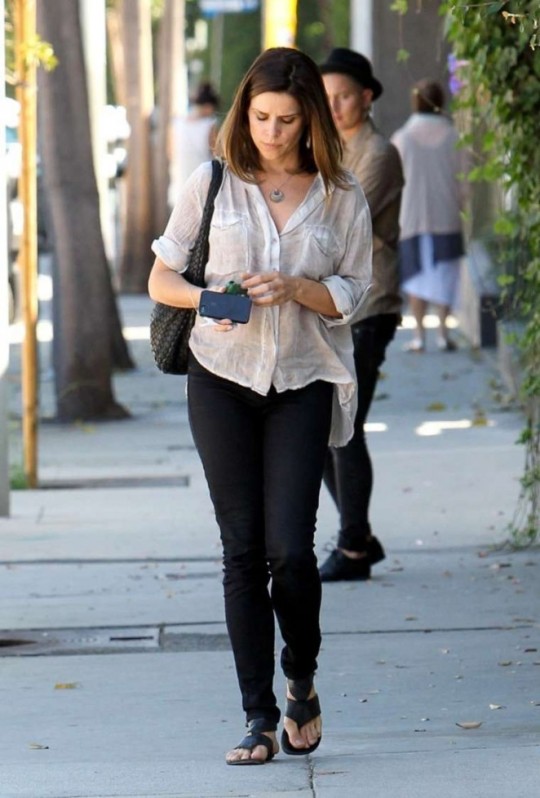
Neve Campbell Body Measurement
Neve Campbell weight: 125 lbs (56.7 kg)
Neve Campbell height: 5' 5½" (166 cm)
Neve Campbell body measurements: 34B-26-35 in
Neve Campbell bra size / breast size: 34B

Neve Campbell Movies
Year
Title
Role
Notes
1993
The Dark
Officer Jesse Donovan
1994
Paint Cans
Tristesse
1994
The Passion of John Ruskin
Effie Gray
Short film
1996
Love Child
Deidre
1996
The Craft
Bonnie Harper
1996
Scream
Sidney Prescott
1997
Scream 2
Sidney Prescott
1998
Wild Things
Suzie Marie Toller
1998
54
Julie Black
1998
Hairshirt
Renée Weber
1998
The Lion King II: Simba's Pride
Kiara (voice)
Direct-to-video
1999
Three to Tango
Amy Post
2000
Drowning Mona
Ellen Rash
2000
Panic
Sarah Cassidy
2000
Scream 3
Sidney Prescott
2002
Investigating Sex
Alice
2003
Lost Junction
Missy Lofton
2003
The Company
Loretta "Ry" Ryan
2003
Blind Horizon
Chloe Richards
2004
When Will I Be Loved
Vera Barrie
2004
Churchill: The Hollywood Years
Princess Elizabeth
2006
Relative Strangers
Ellen Minola
2007
Partition
Margaret Stilwell
2007
I Really Hate My Job
Abi
2007
Closing the Ring
Marie
2008
Agent Crush
Cassie (voice)
2011
Scream 4
Sidney Prescott
2011
The Glass Man
Julie Pyrite
2015
Walter
Allie
2018
Skyscraper
Sarah Sawyer
2018
Hot Air
Valerie Gannon
Neve Campbell Televisions
Year
Title
Role
Notes
1991
My Secret Identity
Student
Uncredited
Episode: "Pirate Radio"
1992
The Kids in the Hall
Laura Capelli
Episode: #3.13
1992
Catwalk
Daisy McKenzie
4 episodes
1994
I Know My Son is Alive
Beth
Television film
1994
The Forget-Me-Not Murders
Jess Foy
Television film
1994
Are You Afraid of the Dark?
Nonnie Walker
Episode: "Tale of the Dangerous Soup"
1994
Kung Fu: The Legend Continues
Trish Collins
Episode: "Kundela"
1994
Aventures dans le Grand Nord
Nepeese
Episode: "Bari"
1994–2000
Party of Five
Julia Salinger
142 episodes
1995
MADtv
Julia Salinger
Episode: #1.6
1996
The Canterville Ghost
Virginia "Ginny" Otis
Television film
1997
Saturday Night Live
Host
Episode: "Neve Campbell/David Bowie"
2002
Last Call
Frances Kroll
Television film
2005
Reefer Madness
Miss Poppy
Television film
2007
Medium
Debra
3 episodes
2008
Burn Up
Holly
2 episodes
2009
The Philanthropist
Olivia Maidstone
8 episodes
2009
Sea Wolf
Maud Brewster
Miniseries
2009
The Simpsons
Cassandra (voice)
Episode: "Rednecks and Broomsticks"
2012
Titanic: Blood and Steel
Joanna
6 episodes
2012
Grey's Anatomy
Dr. Lizzie Shepherd
2 episodes
2013
An Amish Murder
Kate Burkholder
Television film
2014
Mad Men
Lee Cabot
Episode: "Time Zones"
2015
Welcome to Sweden
Diane
4 episodes
2015
Manhattan
Kitty Oppenheimer
2 episodes
2016–2017
House Of Cards
LeAnn Harvey
26 episodes
Read the full article
#NeveCampbellaffair#NeveCampbellage#NeveCampbellbio#NeveCampbellBiography#NeveCampbellbodymeasurement#NeveCampbellbodystats#NeveCampbellboyfriend#NeveCampbellfamily#NeveCampbellfigure#NeveCampbellheight#NeveCampbellhusband#NeveCampbellkids#NeveCampbellmovies#NeveCampbellnetworth#NeveCampbellsalary#NeveCampbellscandal#NeveCampbelltelevisions#NeveCampbellweight#NeveCampbellwiki
2 notes
·
View notes
Text
Vagelis - The Model Spy
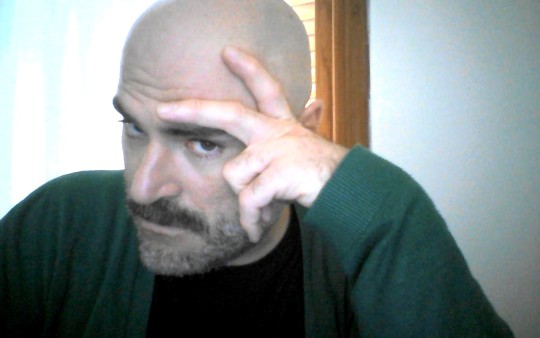
Α piece of music that needs to be played loud
Domenique Dumont - L' Esprit de L' Escalier
A piece of music that moves you forward
Broken Social Scene - Pacific Theme
A piece of music that gets stuck in your head
My Wet Calvin - What Do You Say?
A piece of music that makes you want to dance
Keysha - Stop It!
A piece of music that makes you feel badass
New Model Army - The Hunt
A piece of music that you remember from your childhood
Giorgos Dalaras, Akis Panou - Harokopou 1942-1953 (Stis Paragkes)
A piece of music that reminds you your hometown
Slowdive - Souvlaki Space Station
The piece of music you’ve listened to the most
The Cure - This Twilight Garden
Hi. My name is Vagelis and as far as I can remember my self I always felt irresistibly attracted to pop culture. Collecting glossy stickers in the 80s as a child, watching MTV and sometime later feeling enchanted by the emerging indie/alternative scene it was something like a natural evolution to buy my first electric guitar at 14 years old, a time when (for good, for bad or for worse) the brit pop scene was dominating the indie universe. I tried to teach my own self by trying to play impromptu chords, by badly perform riffs, by getting hold of some books on first level guitar playing and that’s how I kind of learned to strum the guitar. The truth is that I never considered myself as a guitarist, rather than someone who plays a bit of guitar. And I think that this was the main reason I started writing my own songs. It was way easier to perform the things I had written based on my own guitar skills rather than playing other people’s compositions.
The first band that I was involved in should be around 1998 and it was called “Snowing Summer” (a wordy variation of “Snow In Summer” which was a b-side by the Cure). We never played live, we just recorded a live demo of our own songs, but to be honest I do not even know where that tape is.
Moving forward to 2000, some friends and I started playing for fun as a band called “Mad! Panic! Yes!” which was a line a read in a comic book hanging at the studio lobby table during a rehearsal break. We played mostly punk staff, or poppier staff in a punkish way. When we saw that this could go somewhere further, a couple of members of the band and I decided to pull out of “Mad! Panic! Yes!” and create the core of “Paraffin” (the band was named after the single Paraffin by Ruby). By adding a new bassist, a new guitarist and a keyboardist to the band we recorded a demo EP including three songs, “Watch Me Falling”, “No Love Lost” and “Paraffin”. Around that time I also started spinning music as a “two days a week resident DJ” in the beloved POP bar downtown Athens. I deejayed and spent most of my personal time in POP from its (almost) day one in summer of 2001 up to its last day in summer of 2012. 11 sweet years in a row that this bar was way more than just a place with drinks and music. A meeting place for people who loved all kinds of art, a place where special human bonding, deep love and true friendship was founded. So, looking back to 2001-2004 life was music, listening to music, playing cds and records for people, playing the guitar, writing songs, throwing live gigs with Paraffin and somewhere in between a bit of studying economics.
So, it was the spring of 2004 when we substantially broke Paraffin apart. Almost instantly a couple of members, once again, and I created “the Model Spy” (we actually got the name from the track “Model Spy” by Cinerama). Konstantinos joined the group as our bassist and that was it. We were rehearsing and writing songs like crazy, however the band was essentially introduced to the outside small-town world around 2006-2007, with a couple of DIY self-released EPs and singles that were available at selected record stores (like the legendary Vinyl Microstore and the, now, 50 years old Record House) and our live performances in Athens.
Moving amongst the underground indie environment that Athens and My Space explosion were creating at that moment, we were putting together new material, hence the idea of leaving the DIY process for an official recording was more than a goal. It was still back in summer of 2008 when, during a rehearsal break at Sonic Playground studios, Nikos Triantafyllou (long time promoter, producer and sound engineer) stated that he was willing to take over the production and release Model Spy's full-length album. From that time onwards and for months to follow, we would take meetings after rehearsing at the studio on almost every weekend and on as many weekday afternoons and evenings as possible, recording, erasing, recording again. A year or so later, we had recorded fourteen (instrumental) tracks. Even though, the production team was always by our side, however (and unhappily) some of the band members failed at fulfilling their commitment. Sadly enough, long-term friendships were violently terminated and left a half-broken up band and an unfinished record.
Within a couple of years down the road, there was a feeling of unfulfillment for Konstantinos Vavousis (bass) and me. By that time we were leading the project as sole members of the Model Spy while we already had this “morning ‘real’ job” thing going on in our lives, Konstantinos was musically active with various Athenian indie acts (such as My Wet Calvin, Zebra Tracks, Monika, Leon of Athens, etc.) and I was still a part-time local indie DJ (still am). So, essentially the band was led to a hiatus.
Entering 2015 reunion era: There was still a feeling of unfulfillment. By that time, it was as if the band was a “has been” while the few people that had a connection to the band felt like we were another local indie pop act of the Greek My Space generation whose traces were lost. Nonetheless and weirdly enough time was not an issue. We had already waited for too long and it was 2017 by the time we revisited already recorded sessions, and finally decided to follow contemporary indie pop standards. We went back to Nikos Triantafyllou as the man behind the desk, kept the spirit of the album alive, but also started the whole thing from scratch. Adding, the genius of Chris Bekiris (Bhukurah, Devamp Javu, Chickn, the Callas etc. etc.) in coproduction, sound design, additional arrangements and soon were some kind of a new band back together.
Bekiris and Triantafyllou performed their productive magic while Leonidas Oikonomou & Aris Nikolopoulos from My Wet Calvin, Kat (Tango with Lions), Evangelia a.k.a. Miss Trichromi, Leon Veremis a.k.a. Leon of Athens and Jef Maarawi accepted their guest features and gave new life to the songs by endowing their voices. And there you go. Our never-ending debut was finally ready to go, with a little help from our friends. “Serenest (A Long Play On Truth, Deceit And Souvenirs)” was finally released on November 8, 2019. Needless to say that the whole covid 19 thing did not allow our summer 2020 plans to evolve. However we have already been preparing new material within the Model Spy, a solo project (called “Ntentenis” -?-) involving dance music is in the works, my weekly live broadcast through Avopolis Radio is still on for the fourth season, while I keep (part-timely) deejaying non stop since summer of 2000 and the love for music keeps growing like the sea.
https://open.spotify.com/artist/45tInNzhnCBbZSprZnELoz?si=u-imm5CdTYiIZV2T2ixZCA
https://themodelspy.bandcamp.com
https://m.facebook.com/themodelspy
https://instagram.com/the_model_spy?igshid=15p8yowitlx75
0 notes
Text
I tried to write down every scary movie I’ve ever seen and the years they came out
Psycho (1960)
Repulsion (1965)
Rosemary's Baby (1968)
Valerie and Her Week of Wonders (1970)
Tales From The Crypt (1972)
Asylum (1972)
The Exorcist (1973)
The Wicker Man (1973)
The Texas Chainsaw Massacre (1974)
Jaws (1975)
The Omen (1976)
Carrie (1976)
House (1977)
The Hills Have Eyes (1977)
Alien (1979)
Cannibal Holocaust (1980)
The Shining (1980)
My Bloody Valentine (1981)
The Monster Club (1981)
Scanners (1981)
The Thing (1982)
Basket Case (1982)
Sleepaway Camp (1983)
A Nightmare on Elm Street (1984)
Gremlins (1984)
Hellrasier (1987)
Bad Taste (1987)
Opera (1987)
Child’s Play (1988)
IT (1990)
Tremors (1990)
Frankenhooker (1990)
Basket Case 2 (1990)
The Silence of the Lambs (1991)
The People Under the Stairs (1991)
Scream (1996)
Tremors 2: Aftershocks (1996)
Mimic (1997)
Bride of Chucky (1998)
Urban Legends (1998)
Killer Klowns from Outer Space (1988)
Audition (1999)
American Psycho (2000)
Thir13en Ghosts (2001)
Itchi the Killer (2001)
The Ring (2002)
28 Days Later (2002)
Jason X (2002)
Cabin Fever (2003)
Darkness Falls (2003)
Seed of Chucky (2004)
Hostel (2005)
The Descent (2005)
Silent Hill (2006)
The Hills Have Eyes (2006)
Paranormal Activity (2007)
Dead Silence (2007)
The Host (2007)
REC (2007)
P2 (2007)
The Mist (2007)
Behind the Mask: The Rise of Leslie Vernon (2007)
The Strangers (2008)
One Missed Call (2008)
Quarantine (2008)
Martyrs (2008)
Splinter (2008)
Sorority Row (2009)
Orphan (2009)
Triangle (2009)
Zombieland (2009)
Jennifer's Body (2009)
The Descent Part 2 (2009)
Frozen (2010)
The Crazies (2010)
Black Swan (2010)
Piranha 3-D (2010)
The Human Centipede (2010)
Devil (2010)
Apartment 143 (2011)
You're Next (2011)
Red Riding Hood (2011)
The Roommate (2011)
The Cabin in the Woods (2012)
American Mary (2012)
The Woman in Black (2012)
Black Rock (2012)
Sinister (2012)
The Tall Man (2012)
Your Next (2013)
The Conjuring (2013)
Jug Face (2013)
Evil Dead (2013)
World War Z (2013)
Curse of Chucky (2013)
Horns (2013)
No One Lives (2013)
The Machine (2013)
Housebound (2014)
Starry Eyes (2014)
Tusk (2014)
Life After Beth (2014)
Unfriended (2014)
Last Shift (2014)
The Babadook (2014)
Annabelle (2014)
Cabin Fever: Patient Zero (2014)
The Houses October Built (2014)
Coherence (2014)
Stage Fright (2014)
The Gallows (2015)
Krampus (2015)
Southbound (2015)
The Devils Candy (2015)
Stung (2015)
The Lazarus Effect (2015)
Green Room (2015)
The Visit (2015)
It Follows (2015)
The Gift (2015)
Hush (2016)
10 Cloverfield Lane (2016)
Ouija: Origin of Evil (2016)
Train to Busan (2016)
The Invitation (2016)
Raw (2016)
Terrifier (2016)
The Love Witch (2016)
Oculus (2016)
The Forest (2016)
The Monster (2016)
The Autopsy of Jane Doe (2017)
The Killing of a Sacred Deer (2017)
Veronica (2017)
Happy Death Day (2017)
Mother! (2017)
The Babysitter (2017)
Gerald's Game (2017)
Game of Death (2017)
Get Out (2017)
IT (2017)
Downrange (2017)
47 Meters Down (2017)
The Marshes (2017)
Tragedy Girls (2017)
Ruin Me (2017)
Cloverfield Paradox (2018)
The Perfection (2018)
Suspiria (2018)
Hereditary (2018)
Mom and Dad (2018)
Cargo (2018)
Bird Box (2018)
Annihilation (2018)
The Wolf House (2018)
30 Miles from Nowhere (2018)
Await Further Instructions (2018)
The Open House (2018)
Cam (2018)
He’s Out There (2018)
Monster Party (2018)
The Golem (2018)
The House That Jack Built (2018)
Into The Dark: Treehouse (2018)
Into The Dark: Down (2019)
Into The Dark: Culture Shock (2019)
Into The Dark: School Spirit (2019)
Into The Dark: A Nasty Piece of Work (2019)
Scary Stories to Tell in the Dark (2019)
Satanic Panic (2019)
Blood Quantum (2019)
Crawl (2019)
Us (2019)
Midsommar (2019)
The Lighthouse (2019)
Color Out of Space (2019)
Little Monsters (2019)
Depraved (2019)
In the Tall Grass (2019)
The Silence (2019)
Pet Sematary (2019)
Room (2019)
Haunt (2019)
Bliss (2019)
Velvet Buzzsaw (2019)
Random Acts of Violence (2019)
Awoken (2019)
The Cleansing Hour (2019)
Into The Dark: My Valentine (2020)
The Furies (2020)
The Hunt (2020)
Nobody Sleeps in the Woods Tonight (2020)
The Superdeep (2020)
Bad Hair (2020)
Peninsula (2020)
PG: Pyscho Goreman (2021)
Army of the Dead (2021)
A Classic Horror Story (2021)
-----------------------------------------------------------------------------
Full Series I’ve Seen:
Final Destination (2000, 2003, 2006, 2009, 2011)
Scary Movie (2000, 2006, 2013)
Jeepers Creepers (2001, 2003, 2017)
Wrong Turn: (2003, 2007, 2009, 2011, 2012, 2014)
Saw (2004, 2005, 2006, 2007, 2008, 2009, 2010, 2017)
Hostel (2005, 2007, 2011)
The Collector (2009, 2012)
Insidious (2010, 2013, 2015, 2018)
The Purge (2013, 2014, 2016, 2018)
Fear Street 1994, 1978, 1666 (2021)
Rob Zombie Trilogy: House of 1,000 Corpses (2003), The Devil's Rejects (2005), 3 from Hell (2019)
Movie Count to date: 236 horror films watched.
6 notes
·
View notes
Text
Memory cues
It gets harder to journal about anything personal, the more jealous I become of my privacy. But I still have the impulse to share things about my life with the proverbial curious party.
Some guy was walking by as I left the bathroom at work today, and he saw me try to throw a paper towel out into a hallway trashcan from about two inches away and still miss, and he laughed at me. As I bent to pick up the paper towel, he must have seen what I guess was a vaguely wounded look on my face because he turned away and said, “...Almost got it,” not breaking stride.
Then again, I was on a very crowded, cliff-face grate bridge in the Capilano Suspension Bridge Park in Vancouver last month, and I heard a lady behind me say to her companion, “I’m not looking down. I’m just trying not to have a panic attack,” and I said, unsolicited, “Just remember that you’re stuck, and you couldn’t get off this bridge even if you wanted to.”
At that moment of my existence, turning 35 years old was imminent. Was this kind of little rat-fuck joke a sign of things to come? I hope not. I reflexively shriveled up inside and turned around and said “Ma’am, I’m sorry, I didn’t mean to make you more nervous, that was a bad joke.” She laughed, and her husband, I, and my lab partner chatted amiably for the rest of the walk.
I’d never been to the Pacific Northwest before then, but it put sort of a spell on me while I was there, and the next time I go up to that region (Seattle), I suspect I will enjoy that, too. The Capilano Suspension Bridge Park looks like the forest moon of Endor, and the coffee in Vancouver tastes very good (this is coming from a certified non-connoisseur who says “this tastes like dirt” to most cups).
The busiest and fanciest area of the city comes to a halt on its northern end at Vancouver Harbour, which sports green mountains behind a large, clearly too-far-to-swim-across inlet. In the harbor, chubby seaplanes take off and land, their motion dictated as if by cartoon physics.
I stayed at a hotel embedded in a residential neighborhood a few miles south of “downtown,” so I had to take buses and trains to get into and around the city each day. At first I was annoyed, but then I felt like I was getting a better view of what it would be like to live there, which was neat. On public transport at commuter hours I felt both uncoolly older and obscenely whiter than I do at home. Late at night, on the same modes of transportation, I felt doubly old and doubly square.
Life at 35 is like life at 25, except you’ve been around for ten years more, your cultural touchstones are outdated, and you feel more tired spiritually, if not physically. Professionally, you feel more focused; you’ve crossed more items off the list of things that you enjoy doing, and you don’t have the nervous energy you did a decade ago that prevented you from buckling down.
The separation between 35 and adolescence also means that the memories of the old days are more distinct than they were at 25. I think of memories now like opening a fresh can of tennis balls: the smell seems to enter your nose and occupy your brain all the way back to your ears and then it’s gone. For me, the easiest way to access memories is by listening to music.
The abridged version of the music important to me: before I “liked music,” I enjoyed the song “Good Vibrations” and I learned to love the Smashing Pumpkins album Mellon Collie and the Infinite Sadness because my older brother played it constantly. Beck was the first artist who made an impression on me, so seventh through ninth grade was mostly Beck’s Odelay and Mutations. Sophomore year of high school Kid A came out, which led me back through Radiohead for the rest of high school and the beginning of college, with Beck’s Sea Change nestled in there, too. Zwan formed (and mostly disbanded) in 2003, but now it’s forever joined to the endless nights in my dorm freshman year playing Quake II and eating Gerlanda’s pizza by myself. The blistering winter winds waiting for campus buses are inseparable from “When You Smile” by The Flaming Lips, and with the spring came Yoshimi Battles the Pink Robots. Sophomore through senior year of college I zoomed through lots of splashy indie bands, faithfully sticking with the discography of only a small fraction of them (Silver Jews, now Purple Mountains, and Pedro the Lion). During that time, I also learned I disliked Bob Dylan and Conor Oberst (sorry Joe).
After college, Andrew Bird soundtracked the purposeless days of professional indecision pretty well. I walked through my new apartment neighborhood during the soft end-of-summer evenings of 2008 to You & Me by The Walkmen. Beach House came along during Stair-master sessions at my local gym when I was starting out at grad school, as did the ultimately disposable Girl Talk mashup albums. Kanye West made Christmas 2008 feel like looking at a photo negative, but afterward Fleet Foxes and Grizzly Bear/Department of Eagles blew the naturalness back into feeling. Fall of 2009 was David Bazan’s Curse Your Branches and, later, Embryonic by The Flaming Lips.
I was in a relationship from 2012-2015 and got really into Tame Impala during that time. From the relationship, I picked up a few others--Abba, some newer indie bands that didn’t hit my ear as keenly as the ones in undergrad, and Paul McCartney. In 2016 I clung for dear life (personal, not political reasons) to Mac DeMarco’s insouciant vibe, 1970s McCartney, and Lord Huron’s death anxiety. In 2017 things came to an anxious head with Aesop Rock’s The Impossible Kid. 2018 was the beginning of an as-yet undefinable mix of old and new stuff making up the “present period.” Those are the milestones, anyway.
Recently I was reminded of memories from 2004-2006, which was during the splashy indie band phase. I made a mix on Spotify that was as close as I could get to one of the mixes I made for myself at the time, when the city surrounding my college took on a kind of permanent cold, permanent night-world texture. I guess it’s because most of the important stuff during that period happened at nighttime and in the fall or winter. I spent a whole weekend in a bittersweet reverie.
Memory can be a mournful thing, but sometimes its vividness makes you feel like there may still be great things within you yet. At least, I hope so!
0 notes
Text
Death of a Bachelor, Birth of a Billboard-Topping Broadway Badass
Brendon Urie got pretty sick a few months ago. Three days before the Panic! at the Disco frontman’s Death of a Bachelor tour was set to hit Oracle Arena, he lost his voice and his temperature soared to 103 degrees. But he was slated to perform for 11,000 fans at Oregon’s Moda Center that evening.
“Still gonna have fun on stage tonight,” he tweeted before the show. “Fuck a cancellation. Let’s do this, Portland.” The next day, he informed his followers that he’d received a steroid shot in the ass so as not to miss his sold-out Vegas hometown show. Then it was off to the Bay Area.
If there were any Oakland concertgoers unaware of Urie’s social media play-by-plays (unlikely), they would’ve had a tough time deducing that the Panic! frontman felt like anything less than a rock star. He belted out over 20 songs during the March 25 show, including covers of Queen’s “Bohemian Rhapsody” and Billy Joel’s “Movin’ Out.” He took over the drums to bang out a Bruno Mars/Rihanna medley, killing back-to-back renditions of “24K Magic” and “Bitch Better Have My Money.” He nailed his signature backflip during the band’s 2013 song, “Miss Jackson.” Then he packed up, hit the road, and completed 15 more stops around the country (including one in Duluth, GA on his 30th birthday). And then, one month later, he made his Broadway debut.
This is how Brendon Urie gets shit done. And this unrelenting energy and passion have made him one of pop-rock’s biggest success stories. Panic! at the Disco currently counts over 3 million and 2.29 million followers on Instagram and Twitter, respectively, and Urie’s amassed nearly identical numbers across his personal accounts. Panic!’s 2005 debut album, A Fever You Can’t Sweat Out, produced the instantly recognizable, irresistibly catchy earworm, “I Write Sins Not Tragedies,” which became a top 10 hit, peaking at No. 7 on the Billboard Hot 100 singles chart. Not bad for a group of recent high school grads who got their start as a Blink-182 cover band. A year earlier, Urie, along with pals Ryan Ross, Spencer Smith, and Brent Wilson formed Panic! and sent a few of their demos to Fall Out Boy’s Pete Wentz via LiveJournal. Within months, he’d signed them as the inaugural band under his Fueled by Ramen record label imprint, Decaydance.
Phoenix, AZ resident Sarah Fingold discovered the group early on. “I was a Fall Out Boy fan, and they did a tour in 2005 and Panic! opened for them,” she recalls. “It was one of their first tours and no one knew who they were. I just remember them being all flamboyant with their outfits and what I remembered as the ‘Shotgun Wedding’ song [officially known as “Time to Dance” from Fever].”
Fingold has attended 15 Panic! shows over the past 12 years and has, along with other early adopters, stuck by the group through a tumultuous decade. In 2006, Jon Walker replaced Wilson on bass. But two years later, Walker and guitarist Ross both left the band following the release of their sophomore album, Pretty. Odd. Urie and drummer Smith then recruited bassist Dallon Weekes while recording their third album, 2011’s Vices & Virtues, and the trio went on to create 2013’s Too Weird to Live, Too Rare to Die! But in 2015, Smith bowed out of the band and Weekes later downgraded his role from permanent to touring member.
And then there was one.
At that point, Urie had a choice. He could have retired from the music game altogether, content with the band’s solid decade together. Or he could’ve put the Panic! brand to bed and reinvented himself as a solo artist. But instead, he soldiered on alone under the Panic! moniker, writing and producing new tracks from his Los Angeles home studio. And while he recruited Weekes, guitarist Kenneth Harris, and drummer Dan Pawlovich for live performances, Urie himself recorded every instrument on the new material, aside from the horns (he’s mastered guitar, bass, keyboard, percussion, and synthesizer), and he even provided his own background vocals (courtesy of a four-octave range). In January 2016, he unveiled the band’s fifth studio release, Death of a Bachelor. As a one-man act, Urie earned Panic! its first No. 1 album and a Grammy nomination.
“Brendon Urie is an anomaly,” says producer and collaborator Rob Mathes. “He’s a young man who is an incredible drummer and singer with extraordinary range, but also a truly great bass player and a guitarist who can shred along with the best of them. Not only that, but he can do backflips and cartwheels on stage and perform seven shows a week with his voice remaining as powerful as ever.”
According to Mathes, Urie’s musical talent is just the tip of the iceberg, and this absurd amalgamation of attributes makes him an industry exception.
“Add to this no ego whatsoever — none,” he says. “It doesn’t really make sense. He was raised by Mormon parents, and though he has drifted from that tradition, I believe his kindness, politeness, and complete lack of pretension probably comes from that religious upbringing. He never thinks he is the most important person in the room. He’s one of my favorite people.”
Los Angeles-based host and long-time KROQ radio DJ Ted Stryker has supported Urie since his early days. “I’ve been listening to Panic! and interviewing Brendon since close to the beginning — he was never off my radar,” he says. “The dude is a superstar. His stage presence, energy, vibe, work ethic, attitude, style, writing — he does not want to fail.”
And he hasn’t, despite the fact that Panic! could have easily succumbed to the fate of other pop rock acts of the MySpace era, written off as a one-hit wonder. Considering the young group’s quick and sudden rise to fame and the members’ gradual departures, it would have been understandable if Urie had felt entitled to coast on his early success until fans lost interest. But the musician has pulled off a rare feat, artistically experimenting and evolving enough to continuously attract new fans, but never veering so off course as to alienate his original supporters.
“Amazingly, the band has amassed a massive cult following, and in essence, are actually bigger now than ever before in their career,” says Live 105 music director Aaron Axelsen. “They sold out a show at the Oracle in Oakland back in March and continue to generate insane sales and streaming numbers here in the Bay Area.”
“You have this [older demographic] of generation-MySpace who nostalgically love Panic! and have been there since day one in 2004, fused with a new wave of younger millennial fans, basically creating an ideal band for soccer moms and their daughters,” Axelsen adds.
That universal appeal hasn’t just kept Panic! afloat: it’s catapulted them toward greater and greater success, even as the band members themselves have dwindled down to just one. That may be why Urie, while lacking the name recognition of an Ed Sheeran or a John Mayer, beat out both artists by having the highest-grossing tour of 2017 thus far.
It’s the combination of unconditional old-school fan loyalty and newbie devotion that’s kept Panic! thriving. “When the new songs came along, the younger audience took ownership of them,” Stryker says, noting that Blink-182 and Weezer have experienced similar sustained success thanks to the support of a millennial audience.
Case in point: 15-year-old Panic! fan Eva Goldthwaite from Boston. She became a dedicated fan a few years ago after discovering Urie’s outspoken support of the LGBTQ+ community in his lyrics and press interviews. “I’ve grown up in a pretty accepting environment,” she says. “I never realized the true, horrible things that were happening in the world.”
After launching the Instagram fan account @brendon.urie (which now counts 31.5K followers), Goldthwaite was shocked to read comments describing followers’ experiences with homophobia and prejudice. Moved to take action, she and a friend decided to pay tribute to Urie’s message of acceptance by distributing paper hearts in all the colors of the rainbow through the crowd at the band’s July 1, 2016 show in Mansfield, MA. Printed on the cutouts were instructions for attendees to shine their cell phone flashlights through the hearts to create a stadium-wide wave of rainbow colors. Audience members were instructed to start the spectacle once the band launched into the equality anthem, “Girls/Girls/Boys,” which includes the refrain “love is not a choice.”
Urie and his team were blown away by the grassroots effort, sharing their appreciation on social media. Fans in other cities took notice, like 20-year-old New Yorker Raquel DiGiacomo, who co-manages the Twitter and Instagram accounts, @PanicUpdating (16K fans and 17.8K followers, respectively). As Urie prepared to kick off the Death of a Bachelor tour, she and a team of fellow fans spearheaded a national effort to replicate the rainbow.
“We spent hours getting people’s information for each stop on the tour, writing our their handles, Tweeting templates of the hearts, telling people where to buy paper,” she says. “It got so big, the people in Houston managed to turn the entire arena into the pride flag.”
The nightly tradition became a testament to the loyalty of Urie’s fans, and he acknowledged the spectacle in a speech at each tour stop.
“The last tour we just finished was the most inspiring I’ve ever been a part of,” he recently wrote in a letter to Billboard commemorating Pride month. “Thank you to all of you for being who you are. You’re beautiful and I love you.”
Fans love Urie right back — so much that they’re willing to traverse the country to see him fulfill his lifelong dream of starring on Broadway. On May 26, Urie kicked off a 10-week run as Charlie Price in Cyndi Lauper’s Tony Award-winning musical, Kinky Boots. It’s a definite departure from his comfort zone, but the production is, in many ways, a perfect fit for Urie. Lauper’s rock-tinged numbers are reminiscent of Panic!’s theatrical influences, and one eerily prophetic lyric from Death of a Bachelor’s “Don’t Threaten Me With a Good Time” kind of says it all: “I lost a bet to a guy in a chiffon skirt/ But I make these high heels work.”
If the numbers are any indication, he definitely does. In the first week (during which he only performed four of eight shows), Urie boosted Kinky Boots ticket sales by 40 percent (or $315,000) and raised attendance by 22 percent compared to the previous week. His seamless transition from rockstar to thespian has wowed critics and colleagues alike.
“Brendon has been like a sponge soaking up everything-Broadway and putting it into his work,” says Urie’s Kinky Boots co-star, Taylor Louderman. “For someone with such a huge following, you might expect an equally huge ego, but this guy is as sweet as they come.”
Mathes says the new endeavor is an ideal outlet for Urie’s talent and enthusiasm. “He has never had more fun in his life than in Kinky Boots,” Mathes says. “He’s over the moon for it and has never been happier. We know he’s at home making blistering modern rock music, but he sure is loving Broadway.”
Urie’s temporary departure from Panic! hasn’t deterred fans. Goldthwaite’s mom will drive her six hours to see Kinky Boots in July and Fingold will make the trek from Phoenix that same month. DiGiacomo has seen the show twice already and plans to see it two more times before Urie’s final performance on August 6.
Each night Urie has appeared in the show, the stage door has been swarmed post-performance, with fans of all ages pouring onto the West 45th Street sidewalk and coming uncomfortably close to oncoming traffic. And each night, Urie has shown up for fans, smiling for countless selfies, signing an astronomical amount of Playbills, and expressing sincere gratitude for their support.
The fan devotion isn’t simply idol admiration; supporters say the musician’s unwavering commitment to his craft, his community, and the causes close to his heart have motivated their own personal growth.
“Brendon has really inspired me to be a better person,” Goldthwaite says, noting that many of her 31,000 Instagram followers are in search of solace or support. “I do mini-projects where I’ll have people compliment the person above them in the comments, which spreads a little bit of positivity to a lot of people,” she says. “Brendon’s positivity inspired me to become a better person and be there for his fans, just like he is.”
Source: sfweekly
23 notes
·
View notes
Note
what do you know about ryan's dating history can u give a brief rundown
clink and clink. i sure can. this may or may not be brief.
Ryan had a girlfriend who he dated for three years when he was in high school. She cheated on him, and a majority of AFYCSO was written about her.

2005-2006: In 2004, Ryan met former scene queen and current designer Jac Vanek on LJ, where he was a not-so-subtle fanboy.

They dated from October to January of ‘05/’06 until they broke up because, according to Jac, he cheated on her.

2006-2009: Ryan met Keltie Colleen Knight (née Busch) in late August of 2006 when she danced for Panic! at the VMAs. They broke up on February 15, 2009 after Keltie found out that he’d been cheating on her.

2009: In May, Ryan had a fling with Kate Thompson.

They'd been friends since childhood, and they’re still close now.
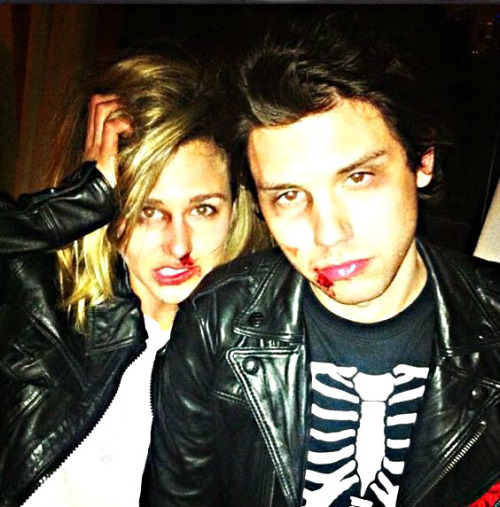
2009: Contrary to popular belief, Cape Town is not about Brendon Urie. Sorry. In April of 2009, Panic! at the Disco played the Coca-Cola Zero festival in Cape Town, South Africa. There, Ryan met a woman, who he quickly became infatuated with (so much so that he planned to move in with and marry her). According to Ryan and Jon during multiple Young Veins performances (I’ll link this one specifically), Jon convinced Ryan to back down, which was a good thing because she was already married to a man who was in prison.
2009-2011: Ryan met Z Berg (formerly of The Like; currently of PHASES) when Panic! at the Disco toured with Phantom Planet in 2008, but they didn’t start dating until after Ryan and Keltie broke up.

It was speculated that Ryan was in a polyam relationship with Z and Alex Greenwald (formerly of Phantom Planet; currently of PHASES). In the words of Keltie Knight herself:

The three of them are still friends.

2015-2016: Ryan started dating model Helena Vestergaard in early 2015, and they broke up in early 2016.

…and that’s what you missed on Glee.
16 notes
·
View notes
Text
Good movies since the year I born
1996 : Trainspotting | Fargo
1997 : Titanic | Liar Liar
1998 : Rushmore | The Truman Show
1999 : Fight Club | Notting Hill
2000 : Memento
2001 : The Royal Tenenbaums | Spirited Away
2002 : Ada Apa Dengan Cinta? | Panic Room
2003 : Eiffel I’m In Love
2004 : Eternal Sunshine of the Spotless Mind | The Life Aquatic with Steve Zissou
2005 : Gie | Dealova | Welcome to Dongmakgol
2006 : Little Miss Sunshine | Happy Feet | Paris Je T’aime
2007 : Juno | Bridge to Terabithia | The Darjeeling Limited | Hotel Chevalier
2008 : Yes Man | Wall-e
2009 : Up | 500 Days of Summer | The Lovely Bones | Up in The Air | Where The Wild Things Are
2010 : Submarine | Inception | Black Swan
2011 : Midnight in Paris | Harry Potter and The Deathly Hallows | 50/50
2012 : Moonrise Kingdom | The Perks of Being A Wildflower
2013 : Her | Miracle in Cell no. 7
2014 : The Grand Budapest | Gone Girl
2015 : Room | Spotlight | Un Homme Ideal
2016 : Lion | Endless Poetry
2017 :
2 notes
·
View notes
Text
best movie of every year i’ve been alive according to me
i hate how many Dudes are going to be in this but let’s try anyways...
1997: princess mononoke (hayao miyazaki)
1998: the big lebowski (joel & ethan cohen)
1999: eyes wide shut (stanley kubrick) his best movie
2000: miss congeniality (donald petrie) my root
2001: mulholland drive (david lynch) / runner up y tu mama tambien
2002: panic room (david fincher) it’s my lesbian duty
2003: kill bill volume i (quentin tarantino)
2004: mysterious skin (gregg araki) a weird choice maybe
2005: mr. & mrs. smith (doug liman, timur bekmambetov) my other root
2006: paprika (satoshi kon) a weak year but it was good
2007: death proof (quentin tarantino) probably best of my lifetime overall
2008: synecdoche new york (charlie kaufman)
2009: jennifer’s body (karyn kasama) it’s my lesbian duty
2010: the social network (david fincher) iconic cinema
2011: hanna (joe wright)
2012: beasts of the southern wild (benh zeitlan)
2013: upstream color (shane carruth) / runner up stoker
2014: ex machina (alex garland) for the lady robots
2015: the lobster (yorgos lanthimos) / runnner up mustang
2016: the handmaiden (park chan wook) / runner up moonlight
tagged to do this by @badwitchclub and @vis-uh-vis (this is julia from weirdfishes btw this is my blog that i made for the cínéma)
6 notes
·
View notes
Link
via Politics – FiveThirtyEight
No offense to the 8.4 million people who live there, but I really don’t care who the governor of Virginia is. I don’t care much about New Jersey’s either.1 I do care a lot about national politics, however, so I’m interested in what next Tuesday’s gubernatorial elections in Virginia and New Jersey will tell us about the national political environment. Should a Republican win in Virginia — where polls have been inconsistent but show only a 3 or 4-percentage-point lead for Democrat Ralph Northam, on average — be cause for Democratic panic? Should Democrats get any credit for a double-digit win in New Jersey (as seems likely based on polls there), or would that just be par for the course?
These questions are tricky. On the one hand, one needs to be careful about finding national lessons in state and local elections (including gubernatorial races). The relationship between local and national politics can be rough: Consider that Massachusetts and Maryland, which are reliably blue in presidential elections, have Republican governors right now, while solidly red Louisiana and Montana have Democratic ones.
On the other hand, while individual governors’ races can be quirky, gubernatorial races on the whole usually do a fairly good job of reflecting the national environment. For example, Republicans turned in excellent performances in gubernatorial races in 2010 and 2014, when they also had great midterm wave years. Democrats did the same in 2006.
In theory, that dynamic should carry over to this year. Because the overall political environment is seemingly good for Democrats, they should expect to perform well in most governors races this year and next, outside of extremely red states. If they don’t, it will be reasonable to ask whether the results in particular states were flukes — or instead, whether the national political climate wasn’t as toxic for President Trump and Republicans as it had seemed.
Let’s look at some data to see how gubernatorial races have behaved historically. I’ve compiled a database of all gubernatorial races since 2001 in which there was no incumbent running (both Virginia and New Jersey are open-seat races this year), excluding races where a third-party candidate finished first or second, or when multiple candidates from the same party appeared on the ballot together.2 This works out to a total of 90 elections.
In those elections, there was a comparatively poor relationship between gubernatorial and presidential voting. In the chart below, I’ve compared the FiveThirtyEight version of a state’s partisan voting index (PVI) — how it voted in the previous two presidential elections, relative to the national average3 — to the margin of victory or defeat for the Republican candidate in open-seat gubernatorial races. A state’s PVI mispredicted the gubernatorial result in 36 of 90 cases, meaning that a state that leans Democratic in presidential elections voted Republican for governor, or vice versa, 40 percent of the time. There certainly is some correlation,4 but it’s rough. The relationship would be much stronger if you’d run the same analysis between presidential races and congressional races instead.
On the other hand, as I mentioned, gubernatorial races usually do a pretty good job of reflecting the national mood when you aggregate enough of them together. In 2006, for example, Democrats won the average open-seat gubernatorial race by almost 10 percentage points, close to their 8-point victory in the total popular vote for the U.S. House that year. Four years later, in 2010, it was Republicans’ turn for a wave. They won the average open-seat gubernatorial race by 8 points, similar to their 7-point margin in the House popular vote.
Gubernatorial races can get swept up in political waves
YEAR NO. OF OPEN SEAT RACES* AVG. PARTISAN MARGIN 2016 7 R +7.7
–
2014 8 R +6.6
–
2012 5 D +0.5
–
2010 21 R +8.0
–
2006 10 D +9.9
–
2004 5 D +2.9
–
2002 20 R +1.2
–
* Excluding races where an independent candidate finished first or second, or when multiple candidates from the same party appeared on the ballot together.
Source: Dave Leip’s U.S. Election Atlas
So what does that mean for Virginia and New Jersey? Using these past gubernatorial races, I built a regression model to estimate gubernatorial results based on the generic congressional ballot — which currently favors Democrats by 9 percentage points according to our tracker — and a state’s PVI. You can think of this as a “fundamentals”-based prediction: That is, what you’d think “should” happen in each race based only on its partisan lean and the overall political environment, without looking at who’s running or the polls in each state.
That regression model says that Democrats “should” win by 9 points in Virginia, and by 13 points in New Jersey, given that the generic ballot suggests we’re in a strongly Democratic-leaning environment and that both states are bluer than the national average (New Jersey more so than Virginia). In New Jersey, that projection pretty closely matches the polling average, which has Democrat Phil Murphy ahead of Republican Kim Guadagno by 15 to 16 percentage points. Virginia is somewhat tighter than the fundamentals project, however, with Northam leading Republican Ed Gillespie by 3 to 4 points.
But note that this fundamentals-based projection isn’t very precise: Historically, it’s missed the final result in each state by an average of about 10 points.5 To put it another way, there’s a lot of room for error: Republicans would still win under these conditions in Virginia 23 percent of the time, and in New Jersey, 14 percent of the time, despite their seeming disadvantages. Individual gubernatorial races just aren’t all that predictable.
Therefore, the challenge of interpreting Tuesday’s results is that there aren’t many of them. While gubernatorial races can tell you a lot once you have enough examples, only two states are voting on Tuesday — and individual gubernatorial races can be quirky. Still, even accounting for the low predictability of gubernatorial races and the wide spread in the polls in Virginia — which have ranged from showing a 17-point Northam lead to an 8-point Gillespie lead — Democrats probably ought to be winning both races. If Northam loses, it will be hard to know whether that says something about Northam and about Virginia — or instead about the national political environment. But either way, it won’t be a great sign for Democrats.
At the same time, if Northam wins, I don’t think analysts should be going out of their way to parse the meaning of his margin of victory (unless perhaps it’s very close or a massive blowout). Races for governor are a noisy signal, and anything from about a 2-point Northam win to a 15-point win would qualify as a pretty “normal” result under the circumstances.
New Jersey shouldn’t be overlooked, either. Gubernatorial races are rarely “gimmes,” so Democrats probably should get some credit for a win there, provided that it comes by a solid margin like the one polls project. New Jersey isn’t the best data point — you’d rather have a state where the candidates were starting off with more of a blank slate and not one where the outgoing Republican governor, Chris Christie, was so historically unpopular. (Guadagno is Christie’s lieutenant governor.) Nonetheless, political analysts and reporters will surely go out of their way to draw implications from Virginia, despite it being just one data point. Do yourself a favor and double the sample size by incorporating New Jersey into the story. That should put your own Wednesday morning narrative on slightly firmer ground.
0 notes